ICCM National Office
City of London Cemetery, Aldersbrook Road, Manor Park, London E12 5DQ
Tel: 020 8989 4661
enquiries@iccm-uk.com www.iccm-uk.com
2023 the journal
Spring
Care in Funerals
Plans for the first Hindu crematorium
Crematorium assessor experience
Mental health and bereavement services
Ashes to admin
Muslim burial requirements
Natural burial and resilience
A look at London’s Victorian cemeteries Pt. 2
Promoting and Developing Best Practice in Cemeteries & Crematoria

The Journal Spring 2023
Why use Burial Vaults?
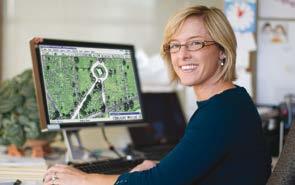
The Atlas II vault is exceptionally strong and protective in its construction.
Coming complete with its own hermetic seal, the twopart chamber is extremely useful and very quick and easy to install.
There is no need to extend any dig sizes to accommodate brick or block constructed chambers, no purchase of cement, mixing or brick laying. These chambers are easily installed by two persons.
The chambers are completely air and gas tight as well as watertight, meaning everything is sealed to the maximum, making them ideal for shallow depth burial as well as peace of mind for bereaved families.

Available now - contact us today to find out more or place an order.
ATLAS II Features
•Hermetically sealed for total integrity
•Incorporates three picture frames on the top panel for personalisation - loved ones can attach photographs, letters and notes as memorials
•Engineered with 32 cross ribs and 12 counter ribbing supports

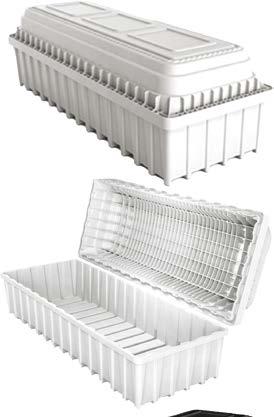
•Engineered with a 180o reinforced channeled edge for additional strength
•Engineered using high-density, water-resistant, non-porous and non-biodegradable polypropylene
•Nestable for easy storage
•Lightweight construction for safe and easy handling
• Certified load-bearing capacity
•Compression strength tested to 12,100lbs
•Consistent .250 wall thickness and numerous 90o corners for structural strength
•Mastic sealant included for a permanent seal

Clear Skies Software Limited, 3 Herald House, 4/6 High Street, Westerham, Kent TN16 1RF Tel: 0870 240 2217 • Email: info@cssmail.biz • www.clearskiessoftware.com Some things just make sense. Clearly. We’ve worked hard on our software so you don’t have to. BACAS is simple to use and can be tailored to your specific requirements. Call ClearSkies Software on 0870 240 2217 for further information or to arrange a demonstration of the BACAS system Some of the many BACAS features are: n Burial and Cremation administration n Register Searches n Memorial administration and Risk Assessment n Finance n Mapping n Telephone Booking n Custom Documents and Statistics n Internet systems including Diary, Genealogy, Bookings and Memorials n Hosting n Coffin lowering device n Register scanning and indexing Bu RIA l AND C R e MATI o N A DMINISTRATI o N Sy ST e M BACAS from t: 01495 212 232 e: info@teleshore.com www.teleshoregroup.com New RANGE OF BURIAL VAULTS - AVAILABLE NOW
The ICCM Journal | Spring 2023 | V91 No. 1 1 Publication & Advertising T: 020 8989 4661 Email: enquiries@iccm-uk.com Subscription Rates £50 per annum (4 issues) Payment to ‘ICCM’, or an official order sent to; Trevor Robson ICCM Finance & IT Manager 1 Colbeck Avenue Swalwell Newcastle upon Tyne NE16 3EB regulars features Accredited COTS & CTTS Candidates 9 Alan Till: an obituary 10 Bob Coates Launch of ashes register 12 Richard Martin Orthometals 13 Orthometals Gravedigger of the year award nominee 16 Marcus Vickers Care in Funerals 19 Vikki Entwistle and Arnar Árnason Plans for the first Hindu crematorium 21 Kevin Smith ICCM recycling of metals scheme 23 Crematorium assessor experiences 25 Lee Macey Our cemetery 30 Keynsham Town Council Cemetery Staff Mental health and bereavement services 31 Sophie Hadley Ashes to admin 33 Evie King Muslim burial requirements 38 Mohamed Omer Official cemetery opening 41 Lawdin Salanha Newark on Trent Town Clerk assists in repatriation of 3 Polish Presidents in exile 43 Matthew Gleadell How to attract new employees as a crematorium or cemetery using social media 47 Eimer Duffy Tales of a cemetery registrar 48 Anita Fish Plymouth's new crematorium project 52 Jasmin McNicholas NI cemeteries and crematoria education seminar October 2022 54 Graeme Arthur Natural burial and resilience 57 Ken West A look at London's victorian cemeteries: Part 2 60 Brian Parsons Prestigious award for Preston Cemetery 65 How to talk to children about death 68 Poppy's Funerals Huntingdon lights up the night 69 Samantha Smith 2023 Published by The Institute of Cemetery & Crematorium Management (Inc) City of London Cemetery Aldersbrook Road London E12 5DQ Printed and distributed by Sudbury Print Group Ballingdon Hill Industrial Estate Sudbury, Suffolk CO10 2DX T: 01787 373421 © Institute of Cemetery & Crematorium Management (Inc.) The Journal is published quarterly in March, June, September and December. Copy dates: 15 Jan, 15 Apr, 15 July, 15 Oct. ISSN 1747-129X Cover image Photo taken by Julie Dunk at West Norwood Cemetery Editorial 2 President's Page 4 ICCM In Touch 8 In Touch Up North 51 Company News 56 ICCM Directors and Officers 71 Advertiser Index 72
Lessons in death
Happy new year and welcome to the Spring edition of the Journal.
Death has always been a difficult topic for most people to talk about. It can bring up many emotions, some uncomfortable, as if by just having a conversation about it somehow will make it happen, therefore we tend to shy away from it.
Death is a significant and inevitable part of life and probably one of the worst things that people will experience in their lifetime. However, in general most people are not prepared for the emotional and physical impact that comes following the death of someone we love or know, or even someone we don’t know, for example when we hear of tragic situations such as the Manchester bombings or Hillsborough disaster, we can experience vicarious grief.
We also know death is random and affects everyone of all ages, children, teenagers and adults. It can happen to anyone of us at any time. As with most skills we learn, this starts at a young age. We accept that education is an important part of our development and we go to school not only to learn and improve our knowledge, but also to develop our social, emotional and interactive skills. So, isn’t it about time that death and dying is included in the school curriculum alongside English and maths?
Schools can provide a safe, constructive space where death is discussed, in an age-appropriate way. It would help children to develop their understanding at an early age and therefore may change how we deal with death as adults – or at the very least we may have a few more tools to be able to cope better.
NAFD President John Adams has started, and is leading, a campaign to add bereavement to the national curriculum. He explains that in the UK every 22 minutes a parent will die leaving behind a child. That equates to 111 newly bereaved children every day. By getting this in place it will help those children to realise they are not alone. It will give their classmates and friends a better level of understanding and empathy, and will aid teachers in signposting and be better equipped in talking to children. If you would like to support this, please sign the petition that can be found at https://www.nafd.org.uk/2023/01/01/petition-add-bereavement-to-the-national-curriculum/
At 10,000 signatures, government will respond to this petition. At 100,000 signatures, this petition will be considered for debate in Parliament.
As it stands now, teachers are not given any bereavement training and are unsure how to support grieving children and young people in their class. A school with a bereavement policy would be better prepared to deal with a death.
It is a natural instinct to want to protect our children from hurt and sadness, but this is an unavoidable part of life. The recent pandemic and the death of the Queen have increased awareness of death and dying for a whole generation of young children. During the long lockdown periods, where children were mostly at home, they were exposed to the 24-hour news cycle including the reporting of daily death rates. By introducing death education at an early age, we would to be able to better equip people to support those who are grieving and empower them to answer questions relating to death in an honest and simple way, rather than avoid it altogether.
We need to start the process of introducing the conversation and not be scared of it. In the words of Haruki Murakami “Death is not the opposite of life, but part of it”.
Sofia Allana Editor
editorial
The ICCM Journal | Spring 2023 | V91 No. 1 2
Design, Production & Support Services

Concept Originators
Environmental ART Engineering
Merging nature and the environment with technology and utilising repurposed materials, we create art through sculpture to enhance any open area, whether in a cemetery, crematoria grounds, park or garden.
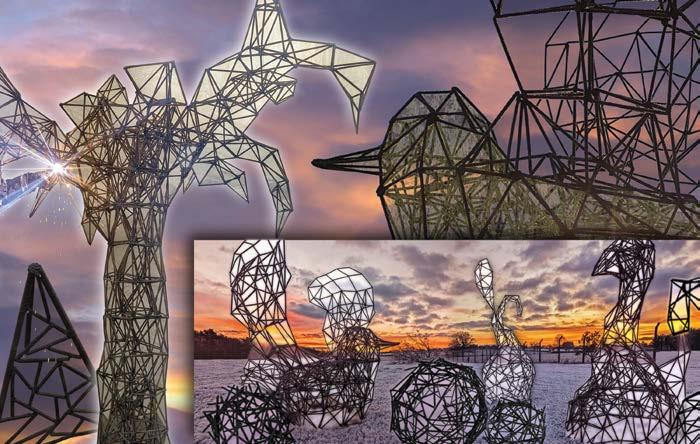
Our Tree of Life sculpture can be installed on existing grounds or on our unique manufactured boulders as shown
All leaves on the tree can be inscribed with a message in remembrance of a loved one
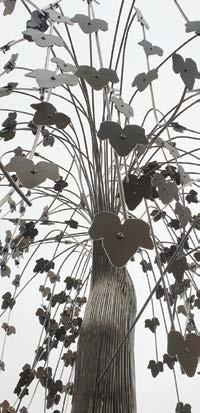

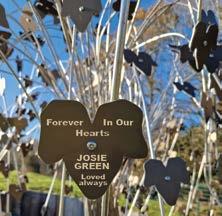
Intellectual
Visit us at www.welters-worldwide.com Or contact us via email: admin@welters-worldwide.com welters ® ORGANISATION WORLDWIDE
Intellectual Property Registration
president's page
Hello Everyone
I hope you are all well.
On Saturday 29th October 2022 I went to the Holiday Inn Southend-on-Sea, with my friend and fellow ICCM Board Member Linda Barker, to attend the British Institute of Funeral Directors (BIFD) gala dinner celebrating their 40th anniversary and saying a fond farewell to President Paul Stibbards and warmly welcoming in Jeremy Mead. The raffle held during the evening raised a lovely amount for the RNLI, such a worthy cause.


Of course, I wouldn’t be upholding my duties without sharing photos of my pudding now would I ��
Sorry I really enjoyed it!!!!
On 4th March 2023 I will be attending the National Society of Allied & Independent Funeral Directors (SAIF) annual banquet at the Spa Hotel, Royal Tunbridge Wells in Kent. I will report back on the puddings ….. I mean the event in my next page.



I hope that you all managed to have a great Christmas and new year. It is so important to make sure that you spend time with family and friends especially at this time of year. As we all know, in our industry, life is precious and we need to make as many memories as we can. With that in mind Codge and I spent new year in Disneyland Paris with my daughter Fern, husband Ryan and our grandchildren Louie and Elsie-Mae, although it rained a fair bit as it did at home, we still went on plenty of rides. If you ever think of going (you may already have been) it is wonderful, and I will share my experience with you with one particular “fast” ride that I accompanied Louie (11) on.
Well you know it is not going to be a leisurely ride when they pull down the padded bars to secure you into your seat and you slowly creep up the steep incline and sit near the top …. waiting…. Then Louie turns to look at me and says; “Nan you know this is going to be fast, don’t you?” Oh yes, too late, off we went at great speed hurtling through the dark, all I could hear was the sound of screams and they were mine!!!! I laughed so much I could hardly catch my breath and I thank Louie for taking me on these rides. I will remember them for many years to come, it makes me smile as I write this, so I hope it is making you smile too. ��
4 The ICCM Journal | Spring 2023 | V91 No. 1
Enjoying a catch-up with Alan Jose.
We all know how both Brexit and the Covid-19 pandemic cancelled many things. Well finally the Law Commission has now commenced their project on “A Modern Framework for the Disposal of the Dead”. It is only still at the consultation and scoping phase but it does provide a rare opportunity for ICCM members to influence the bringing of legislation into line with modern needs and I encourage as many of you as possible to become involved if you are able to. Julie is working hard, as always, to ensure that we have an input into this important issue.
There are still no real changes for everyone with regards to the “Medical Examiner”. However the Ministry of Justice has now confirmed that it is the Government’s intention to work towards implementing the system after April 2023, you can check out the updates and the bulletins issued on the ICCM web pages, where, in the December bulletin, information such as good practice, medical indemnity and the implementation in Wales was reported. I am sure one day it will be up and running everywhere …. hopefully!
With the cost of living and increasing fuel charges this also has an impact on funeral poverty. An open letter to the DWP Secretary of State has been sent by the ICCM calling for the funeral expenses payment to be increased immediately from £1000 to £1725 to be linked with inflation. It is really worrying for people who are often left with a huge debt whilst they are grieving, hopefully the Government will listen and act accordingly.
Don’t forget to look at the web pages for all updates and important information, including dates for meetings and seminars that you can attend.
Although it is January whilst I write this page, we will be soon approaching Spring, and I thought I would share this beautiful little poem which is so poignant to me this month in particular;
Little Snowdrop
The world may never notice If a Snowdrop doesn’t bloom, Or even pause to wonder If the petals fall too soon. But every life that ever forms, Or even comes to be, Touches the world in some small way For all eternity. The little one we longed for Was swiftly here and gone. But the love that was then planted Is a light that still shines on. And though our arms are empty, Our hearts know what to do. For every beating of our hearts Says that we love you.
As always, I send you all my love and thank you for your valued support and friendship.
Heather White
The ICCM Journal | Spring 2023 | V91 No. 1 5

The cloud-based deathcare management solution designed for Cemeteries and Crematoria. Everything you need in one place, giving you more time to focus on what matters most. SCAN TO LEARN MORE To find out about our range of packages or to book a demo, please contact: info@plotbox.io Belfast Boston San Francisco Sydney 028 2582 1005 www.plotbox.io
More time for what matters.
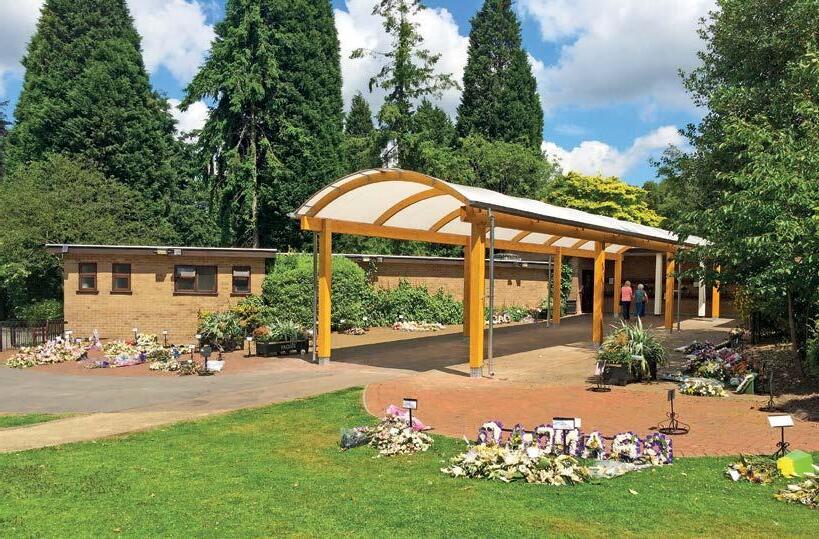





in touch
After a tough few years due to the coronavirus pandemic, we can finally begin to get things back on track. It is important that we learn from what happened during the pandemic so that we can be better informed next time (let’s hope next time is a long way away), but we also need to put it behind us and move on in a positive way. We need to return to putting bereaved people at the heart of what we do, and making sure our services are of exceptional quality.
To assist ICCM members with this aim, we will continue to provide high quality, sector specific, accredited education and training. This year will see our current education accreditation organisation, Pearson, withdraw their services due to the relatively low numbers of students we enrol with them. But don’t worry, we are seeking a different accreditation approach, which we will hopefully be able to report on in the next Journal. In the meantime, Diploma studies can continue and any work already undertaken will still count towards an accredited qualification.

This year we see the return of the Education Seminar as an in-person event. It will be slightly different as our colleagues from Stratford Business School, Sue and Marc, won’t be able to join us physically, but by the magic of technology they will be able to be there remotely. We haven’t quite managed to create 3D holograms of them (yet), but they will be available via videoconferencing to provide their usual sage wisdom and advice to Diploma students. Other tutors will actually be in the room, and will be on hand to provide advice, and to mark completed assignments. The Education Seminar is a great event, not only for providing an opportunity to completely concentrate on your studies, but also to meet fellow members and to make lasting friendships with like-minded people.
The return of in-person events also means that branch meetings can be held, and branch secretaries, supported by ICCM Officers, will be looking at dates, places and sponsors to make these happen. Branch meetings are an excellent opportunity to get together with colleagues and to discuss pertinent topics. As they say, a problem shared is a problem halved, and that is so true for our sector. You can sometimes feel pretty alone, and like you are the only one facing particular issues, but it is so often the case that somebody else has been there, done that, got the medal and is prepared to share their advice freely. The importance of branch meetings cannot be over-emphasised; keep an eye on the ICCM website (www.iccm-uk.com) for details of forthcoming meetings.
In March this year we are holding a one day seminar with the CDS Group on the subject of soil management and drainage. At first glance this might not sound particularly relevant, but if you own, manage or work in a cemetery or crematorium, this is the Seminar for you! Where you have grounds, you have soil and drainage issues, so you need to know what your legal requirements are, and what strategies you need to have in place to meet those requirements. Believe me, the Seminar won’t be dry (excuse the pun) but will be educational, informative, and fun!
Another opportunity for ICCM members to get together and learn is being provided by the Faunus Group. Simon Holden, CEO and Founder of the Group, spoke on the January ICCM webinar about their latest developments with precision organic dispersal, a new method of body disposal using a composting approach but with sophisticated scientific techniques behind it. Simon extended an invitation to ICCM members to visit their facilities in Nottinghamshire and see first hand how the process works and learn about their plans to introduce it in the UK. At the time of writing this we are looking at dates in March; more information will be on the ICCM website.
The ICCM Annual Learning Convention and Exhibition returned in 2022 after a two year hiatus, and it was great to be back. Webinars and online meetings and events are fine and work well, but you can’t beat being in a big room listening to passionate speakers talk about relevant topics. The icing on the cake is seeing the huge range of products and services offered by the exhibitors at the event. This year the Learning Convention and Exhibition will take place at the Chesford Grange Hotel from 18th – 20th September. Further information will be posted on the ICCM website, and you can register an interest by emailing julie.dunk@iccm-uk.com. This really is a don’t miss event as it provides so many learning opportunities for you to take back to your service and instigate improvements.
Looking forward, there is much to look forward to! I’m certainly looking forward to meeting as many members as possible at the various ICCM events being held this year.
 Julie Dunk ICCM Chief Executive
Julie Dunk ICCM Chief Executive
8 The ICCM Journal | Spring 2023 | V91 No. 1
Spring is a time for looking forward, and this year there is a lot to look forward to.
Accredited COTS & CTTS candidates

Cemetery Operatives Training Scheme Courses April 2022 – September 2022
A - COTS 1 Health and Safety and the Burial Process B - COTS 2 Excavator Operation
C – COTS 3 Controlling Risks to Health & Safety in Cemeteries F – Safe Use of Dumpers

Kyle Bayliss A
Andrew Burton B
Adrian Cooper A
Jez Cowen A B
Nick Craven A
Clive Dallimore A B F
Kieron Dixon B F
Evan Drury B
James Duncan B F
Lee Ellery B
Daniel England A
Daniel Farrell B
Jonathan Fletcher A B F
Tarquin Foulger A
John Fountain A
Robert Gatenby A
Jason Godden B F
Les Hales A
Paul Hancock B
Mark Hayward A
Isaac Howe A
Craig Jackson B
Sarah Jones A
Kevin Kill A
Tess Kirby A
Tim Leafe B
Darren Leng A B F
Lewis Madden B
Sue Mawson A
Paul Michie B F
Phil Nelsson B
Martin Penney A
Benjamin Pestell B
John Pratt A
Paul Michael Prescott A B
Lee Rhodes B
Sam Richards A B F
Peter Ridley-Browne A B
Mark Ross A
Shaune Searle B
Aidan Simpson A
Georgina Smith A
Callum Steele A
James Thomas A B F
Roy Thornton A
Darren Turner A B F
Edward Warmington A
Stuart Watson A
Calum Wells A
Luke White A
Graham Woodward A
Crematorium Technicians Training Scheme - October 2022 – December 2022


James Thomas Austin Banville
Rhonda Churchill
John William Craven
Jacqueline De Verre
Damian Michael David Feasby
Naomi Hackett
Linda Jones
Rachel Knott
Lee James Masters
Hope Mary-Mae Nebbeling
Russ Owen
Joshua Read
David Robert Redman
Mark Anthony Rundle
Gemma Thornton
Congratulations to everyone who achieved COTS and CTTS qualifications.
With acknowledgement to all the local authorities and companies, listed below, who ensured that their employees, listed above, achieved recognised industry specific qualifications.
Ardur & Worthing Councils, Bradford MDC, Bromsgrove & Redditch Councils, Buckinghamshire Council,East Grinstead Town Council, Folkstone & Hythe District Council, Harrogate Borough Council, Harwwod Park Crematorium Management Ltd, Ideverde Oaks Road Cemetery, Isle of Wight Council, John O’Conner GM Ltd, LB of Lambeth, Leeds City Council, Maidstone Borough Council, Medway Council, North East Lincolnshire Council, Nottingham City Council, Oxford Direct Services, Pure Cremation Ltd, Reading Borough Council, Rushcliffe Borough Council, S&G Care Services Ltd, Salford City Council, Sailsbury City Council, Southern Co-op, St Neots Town Council.
The Institute provides training and qualifications that are fully accredited by recognised accreditation bodies. Both CTTS and COTS training and qualifications receive outside scrutiny and quality assurance verification by City & Guilds, Pearson and SBS. Such training and qualifications are available to all staff at all levels.
Go to http://www.iccm-uk.com/iccm and click on 'Training' for further information or contact the ICCM national office – email: enquiries@iccm-uk.com or tel: 020 8989 4661
The ICCM Journal | Spring 2023 | V91 No. 1 9
Alan Till: an obituary
Alan Till 1934-2022 - a personal appreciation.
I first met Alan in 1994 when I became involved in the formation of the Confederation of Burial Authorities (CBA). As a councillor for the Perry Hill Ward in the London Borough of Lewisham his portfolio included bereavement services. A small group of us would meet regularly at various locations across south London including his then cemetery & crematorium manager Graeme Sloan, Mike Stride (Croydon), George Nash (Hendon), and Richard Baldwin (Camden). We’d map out a way forward and begin formulating a constitution. As an ‘elected member’ his contribution to the CBA’s success cannot be overstated.
On Monday 21st November 1994 I convened a meeting at Church House, Westminster to assess progress and support for the CBA. Here Alan met Eddie Vick for the first time - he was clerk to Penarth Town Council - they became great friends and their partnership as chair and vice-chair in the early years was instrumental in bringing the smaller burial authorities on board. Indeed, we met regularly at the HQ of the National Association of Local Councils in Great Russell Street to further enhance this relationship.
As chief executive of the CBA it was an absolute pleasure to work with Alan on developing many vital initiatives not least the, always oversubscribed, annual seminars at Warwick and Cranfield Universities. Alan only missed one of the forty meetings in the CBA’s existence. His ‘service record’ being: Deputy Chair 1995-1998; Chair 1998-2001; Deputy Chair 2001-2004; Chair 2004-2005.
It was entirely appropriate that Alan was back at the helm when it merged with the Institute to become its corporate arm. During this transition Alan served on the corporate committee and was elected by his fellow members to also serve on the ICCM board of directors. This resulted in him becoming the first ever ‘elected member' Institute President in 2006.
Every time I saw him he opened with ‘Hello young Bob’, including the last time we met, when he spoke at my wife’s funeral in 2018.
Rest in Peace dear Alan.
a tribute from the iccm
Bob Coates
Alan Till had a long association with bereavement services spanning in excess of 20 years.
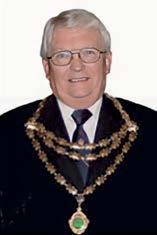
We were fortunate that Alan came on board with the Institute where he helped steer, to name but a few: the metals recycling scheme; achieving accredited qualifications for staff working at all levels within the cemetery and crematorium service; the Charter for the Bereaved Choosing Natural Burial; production of numerous policy and guidance documents focusing on best practice at cemeteries and crematoria; facilitated the absorption of the Association of Burial Authorities’ members when this organisation decided that it would dissolve and merge with the Institute.
The Institute and the CBA before us has been very fortunate to have had the calming and steady hand of Alan fully involved for so many years. Whilst Alan might have been quietly spoken at times, he was instrumental at giving our service a louder voice nationally.
Thank you, Alan.
10 The ICCM Journal | Spring 2023 | V91 No. 1


Showcase your cemetery to better serve your community Request a demonstration today Part of byondcloud, recordkeepr is a mapping and records management solution for cemetries of any size. Simple to use features deliver a wealth of capabilities for less than you imagine. Find the right information as and when it is needed Export reports that help identify cemetery capacity and inform future cemetery planning Easy navigation to burial and memorial locations opusxenta.com 0333 772 1682 Generate customised quotes and invoices Share the history of your cemetery with your community
launch of the ashes register
Official record will provide future generations with details of cremated loved ones’ final resting places
Richard Martin, founder of Scattering Ashes, is to launch an innovative register that records the final resting place of people who have been cremated in the UK, The Ashes Register.
Following his recent report ‘The Lost Generation: the problem of scattering ashes in the modern era’ he discovered that historically the final resting places of those who opted for a cremation have been in churchyards or cemeteries. However since the late 1960s more families have collected the ashes from the crematorium themselves, choosing scattering locations of personal significance but without any means to record the date or place.
The report estimates that up to 6.45 million sets of ashes have been scattered, without any formal record, relying instead on those present to remember the details and pass them on to future generations. These numbers of formally unrecorded resting places have not been seen since the plagues of the Middle Ages.
The Ashes Register has been launched to ensure that families can record a scattering of a set of ashes for free, capturing basic information supplied by crematoria and funeral providers much like that found on a death certificate.
Richard Martin founder of the Ashes Register said: “With an increasing focus on the cremated remains, thanks in part to the rise of direct cremation, families have been creating farewells that are more personalised to the lifestyle, tastes and preferences of the deceased, which we thoroughly support. But a direct consequence is the inability for future generations to know the location of their ancestors final resting place.”
He went on to say: “The Ashes Register will allow every family to record the location of where a loved one’s ashes are scattered plus their date of birth and death, you can even create an entry for someone who passed away decades ago.”
The Ashes Register can offer its basic listing for free thanks to significant industry support, with founding sponsorship from key industry providers: Pure Cremation and Memoria Group, alongside support from the Institute of Cemetery and Crematorium Management where the report was presented.
Catherine Powell, co-founder of Pure Cremation said, “We are proud to sponsor this important project because it will allow grandchildren and great-grandchildren the opportunity to make remembrance visits to the places that mattered to their family.”
Please Contact: Richard Martin 07768 278363, Director@ashesregister.com, The Ashes Register, www.ashesregister.com
Richard Martin
iccm branch secretaries, contact details
Northern: Graham Harrison
Email: Graham.Harrison@durham.gov.uk
T: 03000 265 606
Eastern: Tracy Lawrence
Email: TLawrence@nenevalleycrematorium.co.uk
T: 01933 229 660 or 07904 457 372
South East: Heather White
Email: heather.white@southampton.gov.uk
T: 023 8076 6405
Midlands and Mid Wales: Michael Birkinshaw
Email: bereavement@bromsgroveandredditch.gov.uk
T: 01527 62174
North West and North Wales: Dave Jennings
Email: Dave.jennings@trafford.gov.uk
T: 0161 912 1515
12 The ICCM Journal | Spring 2023 | V91 No. 1
Why not facilitate a branch
Member interaction is the Institute's lifeblood.
meeting?
orthometals
The recycling process
Over 17 years ago, way back in 2006, we embarked on a recycling journey together with the ICCM. A small group of crematoria, just 9 members strong, decided, despite the criticism that it wasn’t legal, or that it would never be accepted, that they should enter an innovative partnership with Orthometals.

In 2007, the material of the first collections were processed, and the first donations were made. The ICCM donated £15,000 to five charitable foundations. At that time, it seemed like a wonderful small thing that had never been done before. Before that day, all the metals would have just been buried as waste. This was revolutionary, and it would benefit charities as well.
By 2013, ICCM was proud to announce that the scheme had donated over one million pounds. After that important milestone, combined with public acceptance, more and more members joined the ranks. And then, just a few short years later, in 2020, the 10-million-pound mark was passed. Today, with 197 participating ICCM members, we are proud to announce that we passed the 15-million-pound mark in July 2022.
It truly is an inspiring success story, and when reading it, it might seem like it was an easy process. We must say that we could not have made this the success it is today without the support, guidance, and open approach from the ICCM board, for which we are grateful.
What we have noticed is that the current set up of the scheme, and the work that we do, might not always be clear to all members. That is why we were glad to be given the opportunity to contribute to this year’s spring Journal.
Orthometals was founded over 25 years ago. We invented the concept of recycling metals after cremation. In the late 90’s, recycling was definitely not top of mind or widely accepted like it is today. In our early years, we traveled all over the world to spread that concept. And today we are still a company that is completely focused on the funeral industry. We believe that only a highly specialised, transparent, and innovative company can offer this service in the niche market in which we operate. Currently, we are servicing crematoria in over 30 countries, on 4 continents.
OrthoMetals collects from participating crematoria and processes the collected material per crematorium. We take care of the collections with our own staff and material in order to ensure the highest level of service. Thankfully, Brexit did not interfere with our current set-up and did not contribute to much higher costs. Custom formalities actually enable us to track and control the collected material even better. During the pandemic lockdowns it became a bit more challenging to collect during some periods, but we are still thankful for all the understanding and flexibility we received during that period. It made us realise that it would be more efficient if we had a hub in the UK, so in 2021 we started to use a warehouse location in the middle of the UK. This helps us to be even more efficient, and to keep the logistical costs under control.
After collecting the material, it’s brought to our sorting facility in the Netherlands. By using state of the art techniques, handled by our highly trained staff, we are able to retrieve all the valuable materials out of the metal. We process each crematorium’s collection individually, and use this data, which we have been collecting for almost two decades, to help crematoria learn how to handle the
The ICCM Journal | Spring 2023 | V91 No. 1 13
metals that they are dealing with. This open, honest, and transparent way of working has helped many crematoria to generate even higher proceeds that they can then donate to charity.

The sorting results, with a breakdown per site, is then sent to ICCM. ICCM accumulates all of the results and then divides the total sum of a collection period by the number of members.
Crematoria can nominate a charity, and ICCM will check if the charity is approved by its standards, upon which the donation will be made. ICCM is always trying to keep up with the requests from their members on which charity they would like to donate to.
Back in 2006, the most important criteria for charities was that they should be national, and death-related. It was always thought that the safest way to make sure people accepted the scheme and adopted it, was to show absolute transparency in the donations. That principle has not changed, and this scheme has become an enormous success, as everyone is united in which charity they could nominate, and how much money the organisations would receive.
For the first couple of years, all donations were allocated to national charities. However, due to members’ requests, the criteria were reviewed, and local deathrelated charities were also considered. Scheme members asked, ICCM answered, and things really grew from there.
ICCM stated that only a single charity could be nominated each time, due to the length of time needed to process all the nominations. Now members also have the opportunity to nominate more than one charity during each round.
It is essential that the criteria needs to be fit for purpose, not just for now but for the years to come. It has expanded to cover counselling services, death prevention though medicine and treatment, end of life support, and any charity that can show that it either makes a difference to the families of the deceased or helps stop people from becoming deceased.
ICCM plays a crucial and excellent role in handling the funds. As a participating member, you can be sure that 100% of the revenue is donated directly to charity. The media presence is handled professionally, and individual crematoria are always supported when needed. The support and gratitude from the general public comes from the groundbreaking way that ICCM has put this scheme in the spotlights – with integrity and honesty. They are an example that many try to follow and have set the standard high for future endeavours.
By being part of the ICCM scheme, as a member, you know that safety and transparency is guaranteed and that the bereaved can take comfort in the fact that 100% of the funds raised will go directly to bereavement-related charities, in order to help others.
We would also like to share some exciting news with you. Just a few weeks ago, we signed to lease our brand-new sorting facility. We moved into our current location in 2015, and we outgrew this site within seven short years. Our new site will be nearly 4 times the size of our current location and will host a dedicated innovation centre which takes our sorting capabilities to the next level. We believe that if we are able to further improve our sorting methods and make them even more efficient, we can maintain the level of costs, and pass that on to our clients. We hope to open our new site in early 2024. We promise you an invitation when we are ready to celebrate our opening!

Looking back on the past 17 years that we have been running the ICCM recycling scheme, we are proud that you, all 197 participating members, are still united in this collective. ICCM has made over 2,200 donations to important causes, and over 600 different charities have received much-needed funds. We feel very honoured and are proud that we have been able to contribute to this success.
Together you are safeguarding that, with the guidance from ICCM, the donations collected are only used for what they are meant for -to help the bereaved during the most challenging time of their lives. We would like to thank you for your trust in our company, and we look forward to the future. We are excited to work even harder, and to share our success with those who need it most.
14 The ICCM Journal | Spring 2023 | V91 No. 1
Orthometals
WE ARE GENEALOGISTS. TRACING MISSING HEIRS FOR ALMOST A CENTURY.

Next-of-kin enquiries for Public Health Funeral Officers

At Fraser and Fraser we know that when you arrange a funeral under s.46 of the Public Health Act you may need help tracing the family of the deceased. Whether or not they want to take on the funeral arrangements themselves, they’ll have the opportunity to attend and pay their respects.



Fraser and Fraser traces family members all over the UK and the rest of the world and has been working with the Public Sector for more than 50 years. Whenever you ask for help, we become temporary custodians of your reputation and, as you’d expect, we conduct all our enquiries with tact, discretion and sensitivity.
All our tracing services are free of charge to Local Authorities. To find out more contact Nick Beetham on 020 7832 1400 or nickbeetham@fraserandfraser.co.uk

GENEALOGISTS AND INTERNATIONAL PROBATE RESEARCHERS SINCE 1969
gravedigger of the year award nominee
Digging graves can be a tough job for any man, the weather conditions, soil conditions, the health and safety risks, the geological understanding and the empathy of dealing with bereaved families both during and after a funeral.
If it’s a tough job for a man, many would say this is an even tougher job for a woman. Maria doesn’t just equal the ability of a grave digging male, she exceeds it. Maria is one of few (if only) female grave digger in the country (at least that I am aware of). She can dig graves by hand, or by plant and as well ensure the statutory requirements and maintenance are fulfilled.
However not only does Maria provide an outstanding service, she exceeds and brings in her wealth of horticultural qualifications and knowledge to support in wider cemetery maintenance and biodiversity.
Maria has maintained, pruned and where needed, felled trees, as well as plant trees both as part of woodland burials, and as part of supporting Middlesbrough council’s successful bid to hold tree city status contributing to 10k trees being planted over the last year.
Since joining the service Maria has developed her skills and knowledge and holds both Institute of Cemetery & Crematorium Management – Crematorium Technician (CTTS) & Cemetery Operative (COTS) qualifications, and has taken on further development in exhumation, memorial testing, exclusive rights of burial, cemetery management and other industry related training. As well as obtaining other skills and qualifications to be hands on within the 6 active working Middlesbrough council cemeteries including chainsaw, woodchipper, strimming, grass cutting, plant driving, CPC licence, spraying, mowing and many others. As well as also recently starting memorial masonry training (fix & repairing headstones) to add value to the service, and subsequently to all residents of Middlesbrough using or visiting Middlesbrough’s cemetery and crematorium grounds.
Maria has also brought her skills of computer animation degree qualifications to plan, design and look at digital alternatives such as online memorial forms, design and planning along with her horticultural qualifications, wildflower graves and areas to support biodiversity and green initiatives.
She has thought outside the box and looked at new ways of working to improve our service and support to bereaved families including maintaining trees with appropriate equipment, but utilising branches and chipping these using woodchipper equipment, in order to be used within graves for greater aesthetics. Renewing how the team work and function to take soil away from grave side, and improve burial graveside appearance making it safer, healthier and a much better all-round experience for the bereaved families.
She has built links with her Italian community that helped in the establishment and creation of mausolea, one of few (if not the only) bereavement service to have such a grave facility in the North East.
In the words of a famous Middlesbrough resident, I wouldn’t say Maria is the best gravedigger in the country, but she’s certainly in the top 1. She has broken the mould of a male dominated service and operations directorate, and leads by example, with Middlesbrough council now employing 2 female gravediggers, and females being appointed into other area care maintenance operative roles. Her hard work and principles have led to her being promoted to team supervisor overseeing and being responsible for day to day operations of crematorium and all 6 Middlesbrough cemeteries covering over 120 acres, with 50 acres as designated nature reserve status and over 100k graves dated back to 1860s, for a service that averages 2-2.5k cremations, and 250-350 burials per year.
If Maria isn’t the only female gravedigger in the country, she is certainly the only female, Italian, multilingual, BA hons, computer animation, horticultural, Arbour, Pastry chef, Crematorium Technician, Cemetery Operative, Saxophonist, Artist/ Painter, JCB & Dump truck licensed and qualified digger in the country.
Maria Brancati was the Association of Good Funeral Directors/Green Funeral Directors Grave Digger of the year 2022.
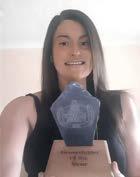 Marcus Vickers Operations Manager Bereavement Services, Teesside Crematorium
Marcus Vickers Operations Manager Bereavement Services, Teesside Crematorium
16 The ICCM Journal | Spring 2023 | V91 No. 1
Maria Brancati (Middlesbrough Council)
FT III Cremator

FT cremators are not only the most advanced but also the most c ost efficient cremators on the market



Facultatieve Technologies (FT) with over 140 years of experience in cremation is the international market leader in the design, construction and maintenance of cremation and filtration equipment.



Our products meet the most stringent environmental legislation and we offer cremation solutions worldwide together with a full range of cremation equipment including coffin loaders, cremulators and ash transfer cabinets.
Facultatieve Technologies gives advice and support on the whole cremation process. Our product range is extensive and we are therefore able to supply the ideal product in any situation. Facultatieve Technologies provides excellent support and maintenance services anywhere in the world.
FT is part of ‘the Facultatieve Group’ and benefits from knowledge and experience of cremation dating back to 1874.
Feel free to contact us:
T: +44(0)113 276 88 88 E: info@facultatieve-technologies.co.uk
In addition, our dedicated customer care department offers full support and back up and our on-line diagnostics means that we can view any problems remotely and often solve them without the need for an engineer to attend site. www.facultatieve-technologies.com
Cemetery Development
TGMS Ltd is one of the leading consultancy practices in the country specialising in the development of new cemeteries and cemetery extensions. In order to provide our clients with a premium service, we employ some of the most highly qualified and experienced engineers and consultants in the industry.
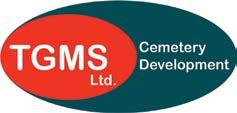
TGMS offers an extensive range of services to support Cemetery



Stage 1
Feasibility study
Stage 2
Design

Stage 3
Tender process
Stage 4
Project management
Contact us: TGMS Limited
EA Tier 1, 2 or 3 risk assessment
Site survey

Development recommendations

from inception of a
development project through to practical completion.
Liaison with the Environment Agency/SEPA



Development of conceptual designs
Detailed designs, specification and drawings
Assistance with a planning application

Production of contractual documentation
Despatch of tender packs
Analysis of tender returns
Appointment of contractor
Management of construction works

Construction materials testing
Interim and final valuation certificates
Quality control throughout the project
4 Doolittle Mill, Froghall Road, Ampthill, Bedfordshire, MK45 2ND
Tel. +44 (0) 1525 307060
richard.earl@tgms.co.uk
www.tgms.co.uk
Managers
cemetery
care in funerals
Learning from experiences during the COVID-19 pandemic
As some members heard during the 2022 ICCM Learning Convention and Exhibition, a team of researchers from the University of Aberdeen have been studying how death rites and ceremonies changed in the first two years of the COVID-19 pandemic. By listening to people’s experiences of disruption and adaptation, we sought to learn more about what people value, or what can matter to people, and why, in funeral provision.
We interviewed a diverse sample of (a) people who had been bereaved, (b) funeral directors and other people who work or volunteer in the provision of burials and cremations, and (c) religious and non-religious funeral officiants. In total, 68 people spoke to us in detail about funerals they had been involved in between March 2020 and March 2022 (and often about funerals they were involved in before the COVID-19 pandemic, in comparison).
ICCM members can probably remember all too well the abrupt and far-reaching disruption to funeral provision in the early stages of the pandemic. New laws and regulations introduced to reduce or manage the risks, patterns of infection and exposure to the virus, and people’s various responses to the pandemic situation and its many uncertainties all affected the working practices of death care professionals and the size, timing and conduct of social gatherings for burials, cremations and associated funeral rituals. Communication with clients was impacted, both by constraints on physical meetings (which prompted shifts to greater use of telephone, email etc.) and as professionals needed to explain that some previously ‘usual’ levels of service provision and forms of funeral activity were not possible.
Bereaved people from different parts of the UK, with different religious and cultural backgrounds and different family traditions and circumstances were affected in different ways. We give just a few examples here.
• Many people were upset when those who died were left in body bags or otherwise not washed, dressed or treated with the expected forms of care.
• Religious communities, including Jewish, Muslim and Hindu communities, were at first unable to complete important religious rituals of washing and shrouding people who died. People who usually led these rituals often worked quickly to develop COVID-safe processes consistent with their beliefs.
• Families and communities who usually pay respects to a person who died in an open coffin, and who spend time mourning privately or socially in their presence, were often unable to do so. The Irish custom of holding wakes in a family home was one of the traditions affected.
• Delayed access to crematoria and restrictions that prevented the dispersal of ashes in flowing water, disrupted the timing of several important Hindu rituals linked to beliefs about how and when people’s souls move on from their bodies.
• People were often unable to support those who had been bereaved, whether by participating in customary practices such as sitting Shiva (in Jewish traditions), celebrating Nine Nights (in African-Caribbean traditions) or through less formal neighbourly visiting.
• Scottish family members were sometimes precluded from ‘taking a cord’ to lower a coffin. Some funeral directors made this possible by cutting the cords and having people take their part away or put it in the grave.
• Some African-Caribbean mourners were prevented from taking part in the backfilling of graves. Some then made this possible by taking their own spades to gravesides.
• Many families and communities were unable to gather in the numbers they usually would for their funerary ceremonies. Adaptations to broaden participation included planning routes for hearses that would allow more mourners to come out and show their respect as a coffin passed by and livestreaming and recording funeral services so people could participate in or witness the funeral online.
Although the activities affected and the meanings people attached to them were diverse, project participants from different backgrounds had a lot in common in terms of how they experienced the disruption. Most people accepted that some precautions were necessary for community protection, and some who had been bereaved by COVID-19 urged more caution because they did not want a funeral gathering to contribute to another death. Some people considered the funerals they achieved “good in the circumstances” and a few saw silver linings, for example, if they welcomed a smaller, more intimate funeral gathering. Overall, however, the disruption had significant adverse impacts. Some funeral professionals, as well as people who were bereaved, were deeply distressed by their experiences.
The depth of distress is understandable because death is a significant event and represents an important loss in relationships and communities. Taking part in ritual activities when someone dies is often regarded as a matter of significant responsibility, as well as potentially important for emotional wellbeing. If people cannot ensure or contribute to a ‘good’ funeral for those
The ICCM Journal | Spring 2023 | V91 No. 1 19
they take responsibility for (whether in professional, family or community roles), they can experience disappointment and moral distress that are not fully relieved by knowing that circumstances were beyond their control.
The people who took part in this study agreed that funerals are important practices of care for the dead and the bereaved, although they exemplified this in diverse ways. Our research confirms that death rites enact a plurality of values and serve a range of important purposes in:
• the care of people who have died (including their bodies, souls, reputations and relationships);
• the care of people who have been bereaved (including to meet their needs to participate in funeral rites to show care for those who have died); and
• care within the broader community and the fostering of social relationships.
The diversity of funeral traditions in the UK, and the variety of meanings and relative priority that people attach to particular practices, makes the ambition of ensuring good funerals for all practically, ethically and politically demanding.
Ours was a qualitative research study, but what we heard supported the findings from other research that minority ethnic groups bore disproportionate burdens during the COVID-19 pandemic. Not only were death rates higher among these groups, their religious requirements and important cultural traditions were often not well accommodated when policy and service priorities were set. A background of social discrimination made some people in our study wary or even fearful of reprisals for any perceived non-conformity to regulations, or even just ‘difference’, in their funeral practices. Project participants anticipated that discriminatory practices and other problems affecting funeral provision would continue beyond the pandemic.
Overall, our study confirms that significant distress and harm resulted when people were thwarted from fulfilling the various caring purposes of funerals during the COVID-19 pandemic. We believe there is a strong case for prioritising the safe accommodation of diverse funeral needs in future emergency planning, and for more attention to the quality of funeral provision more routinely.
Care in Funerals Casebook
In addition to reporting our findings in more detail in academic papers, the main output of our study is the Care in Funerals Casebook. This free-to-use online resource aims to support reflection on and discussion of some of the many practical-ethical concerns that can arise after people die, and the various values that are - or perhaps should be - enacted in funeral provision.
The Casebook includes 12 case stories that illustrate situations that people have found difficult and decisions or actions that people have disagreed about. One example, which was shared with delegates at the ICCM Learning Convention and Exhibition, involves Jo, who works for a funeral director.
In the story, Jo struggles to know what to say or do in an encounter with other funeral operatives who are aggressively disrespectful of the bodies of deceased people in a temporary mortuary set up to accommodate the unusually high numbers of deaths during the COVID-19 pandemic. Jo’s case and each of the case stories is accompanied by a set of suggested questions for reflection and discussion, and by one or more commentaries that provide background information or insights and ideas from different professional, religious or cultural perspectives on a case.
Although the casebook may be used by anyone with an interest in death and funeral provision or the practical-ethical questions that arise in everyday life, we hope that it will be particularly useful for people who work or volunteer in deathrelated services, as well as to people who are considering working in those services. It does not purport to tell you what should be done in particular situations and it is not a recipe book for good funerals, but we hope it offers an opportunity to acknowledge the kinds of practical-ethical concerns that can arise in funeral provision and to think about the values you would like to see upheld in your work and the ways you think people’s different funerary needs and priorities can be appropriately navigated.
The Casebook is available to view 2023 at https://www.abdn.ac.uk/care-in-funerals-casebook. We would be delighted to hear how you find it, what if any difference it can make to your work or the way you think about it, and how you think the Casebook can be improved. We are already thinking about scope to expand the range of cases and commentaries – please let us know if you have any ideas or requests!
Vikki Entwistle and Arnar Árnason Care in Funerals project team
20 The ICCM Journal | Spring 2023 | V91 No. 1
plans for the first hindu crematorium

Over 100 years ago, an Indian lawyer named Mohandas Gandhi helped to facilitate the building of a brick crematorium to cater specifically to the Hindu population of Johannesburg, South Africa. Today, Kevin Smith, Director of Nottingham-based architects Marchini Curran Associates, is working with the Anoopam Mission to help realise a similar vision at the site of their temple in Denham, near Uxbridge. Planning permission for the development was granted on appeal in December 2021, the appellant’s team having successfully argued in qualitative and quantitative terms that the need meant the proposals met the high threshold to allow development on this auspicious site in the green belt.
Only a few years ago, the Government published a response to a review entitled “Crematoria Provision and Facilities”, for which the views of faith groups and industry providers were sought to consider whether crematoria in the UK are “fit for purpose and sensitive to the needs of all users and faiths”. This review had been announced in response to concerns that crematoria did not always have the capacity desired by nor address the cultural needs of different faiths, particularly those from the Hindu, Sikh and Jain communities for whom cremation is (in most cases) not a matter of choice.
However, whilst the review’s findings provided a context for improvements to be made to existing crematoria or to be considered in the design of new facilities, the framing of the questions has meant that most of the advice is of a practical nature and, whilst valuable, it misses a fundamental point. These crematoria are communal, “everyman” facilities. Older municipal crematoria often have a distinctly Christian iconography, and newer (and, increasingly, privately-operated) developments are less overtly “religious”, presenting a blank canvas to be filled in as needed. Sometimes the opportunity is offered to book a double slot (at additional cost) in order to accommodate a longer ceremony and the timing of the coffin being charged to the cremator. Some crematoria may have additional capacity for larger gatherings. However, the pungent scent of incense, the sound of drums, scattering of bright pigments, the placing of sacred woods in the coffin, or a lamp in the mouth of the deceased – these and other ritual elements can prove difficult to accommodate and are most often refused. What the UK’s Hindu, Jain and Sikh populations have always been without is any dedicated facility that they might call theirs, a space in which they might undertake the richly varied funereal rites and rituals that their culture, traditions, and beliefs dictate.
In 2009, a Hindu spiritual leader named Davender Ghai had challenged Newcastle City Council over its decision not to grant him permission for an open-pyre funeral in keeping with centuries of tradition; the pyres at India’s oldest city of Varanasi burn day and night, the bodies of the deceased being properly prepared and anointed with sacred herbs, oils and flowers, before being set ablaze leaving the mourners to await the cracking of the skull and the release of the ãtman, or spirit. The case ended up in the Court of Appeal, where the claimant won, albeit there would be a number of practical limitations imposed if carrying out such a ritual in the UK. Seemingly though, most “Western Hindus” do not wish to take things so far, but the case drew out a number of interesting and compelling supporting arguments, not least that written by the late anthropologist Roger Ballard, who provided the analogy of the “pinching shoe” to describe the way in which the community has stoically put up with compromise to their wishes – and infringement of their rights – for so long. There are now estimated to be in the region of 1 million Hindus in England alone, a significant part of our diverse multi-cultural population. Many are from families who settled either in the post-war years or in the forced expulsions from post-colonial African nations in the 1970s, and there
The ICCM Journal | Spring 2023 | V91 No. 1 21
continues to be positive migration of skilled workers from India and other countries. There are at least 200 places of worship, and over 400 community groups and organisations registered. Yet there is not yet a single Hindu crematorium.
The proposal at Denham is not simply for a “crematorium” per se – rather, it is for a facility that provides the same technical function, but within a faith-specific setting in which to properly observe the ritual and cultural traditions, unhurriedly and with meticulous care, in accordance with the customs and wishes of the bereaved family, whilst allowing the rich variety of individual beliefs to shape the ceremonies within a framework that is universal to all Hindus. It is perhaps helpful to consider the difference in the same way that one might consider a Hindu temple as being somewhat different to a Christian church. It would be wholly unacceptable to expect those of another faith to worship in a church, and one might feel that providing a “multi-faith centre” as a shared space for worship is a compromise for all.
The architecture itself is – despite the larger scale of the proposal – to be purposely restrained, designed simply as a container for the ritual, technical and administrative functions hosted inside, and to sit unobtrusively in its woodland setting. Each space within reveals itself quietly as the mourners progress through the building, allowing their focus to remain on the deceased, and their final journey. For death is the last samskãra, one of the sacred rites of passage that mark the milestones of this life. This journey starts with a private ceremonial space, where close family are given the opportunity to perform various rituals including the anointing of the deceased, and the circumambulation of the body by mourners reciting prayers, preparing the deceased for cremation. This ceremony may take up to an hour, usually concluding in the closing up of the coffin and its transport into the main ceremony hall, where the wider gathering of mourners can celebrate and pay their respects to the memory of the deceased, and prayers can be given. This ceremony will take approximately 45 minutes, after which the majority of mourners will depart.
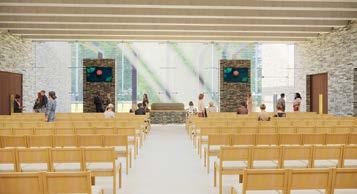
At the conclusion of every ceremony, the body must be charged to the cremator, witnessed by the family. It is desirable that the lead mourner - often the eldest son of the deceased – play an active role, as the space housing the cremator effectively becomes the shmashãna - the Hindu cremation ground, and the oven a vessel for the fire god Agni to become manifest as Kravyãda, the eater of corpses, to devour the flesh of the dead in flame and return the earthly body to the 5 elements. The fire is then left to burn, and mourners depart, the ashes being collected later for dispersal in running water elsewhere.
It is the need to have a cremator ready for charging at the end of every ceremony that presents a challenge to most operators since this places a limit on the number of ceremonies that can be held each day – not necessarily a problem when there are few Hindu funerals to accommodate among the everyday bereaved content with their allocated 30 minutes and less concerned with what happens beyond the velvet curtain. But when every funeral is a Hindu – and projected mortality statistics indicate that an exponential rise in the death rate is coming – this needs to be built into the business plan.
Whilst customs vary, the development will also offer the possibility for those who have attended the funeral to cleanse themselves of the “impurity” of the cremation ground and partake in a simple meal of rice in a small pavilion before visiting the temple for darshan – viewing the deities – before returning home to observe the period of mourning and undertaking the daily rituals that help the disembodied spirit reach the heavenly realm of the ancestors where it will reside until reincarnated.
Last summer, the Mission’s spiritual leader Guruhari Sant Bhagwant Sahebji attended a special Bhumi Poojan Ceremony to bless the site of the proposed crematorium, and the community is actively fundraising with some significant donations having been pledged. Tender negotiations are progressing with building contractors, and the design team is underway with discharging pre-commencement conditions with a view to construction commencing later this year.
Kevin Smith Architect & Director, Marchini Curran Associates
22 The ICCM Journal | Spring 2023 | V91 No. 1
iccm recycling of metals scheme
Press releases and information from charities that received funds in the latest round of recycling of metals nominations


Wealden Crematorium - You Raise Me Up
The charity was founded by the late Jane Brooks and her husband Fraser in June 2011, after finding themselves in desperate need of comfort after their daughter collapsed and died suddenly. The charity’s sole purpose is to raise funds to support families suffering the loss of a young person aged 16-25 years.
The crematorium is part of an Institute of Cemetery and Crematorium Management scheme, which sees recycling of metals following the cremation of a deceased person –done with the written consent of each bereaved family. Metals are recycled by the ICCM with proceeds shared between its members to donate to their chosen charity – and this year Wealden Crematorium chose You Raise Me Up, which has a coffee shop and support centre in Polegate High Street.
Councillor Pam Doodes, Wealden’s portfolio holder for Public Health, said, “This year we chose to donate to You Raise Me Up because of the wonderful work it does to provide compassion and support to families dealing with the bereavement of a young adult.
“I am very happy we are donating the money to the East Sussex based charity so that their important and selfless work can continue.”
You Raise Me Up’s Leesa Pattison, CEO of You Raise Me Up, said, “Without the amazing support of people and organisations like the Wealden Crematorium, our charity wouldn’t be able to continue. “The donation that we have been given will help pay for our helpline to stay open for two years and support groups and it will fund one family’s care for two years.”
Wealden Crematorium is a Wealden District Council run state of the art facility set in 25 acres of rural countryside on the A267 just south of Horam. It offers multi-faith services and welcomes people across the country.
Harrogate - Our Angels
Our Angels, a charity set up by grieving parents, has received a cheque for £12,000 raised by recycling metals recovered from cremations.

The money was donated by Harrogate Borough Council, whose bereavement services sell off the metals twice a year, with consent from bereaved families.

The recycled metals include those used in the construction of the coffins and in orthopaedic implants such as replacements hips and knees and replacement joints.
Our Angels was formed in January 2009 when a group of bereaved parents joined together to support families who had lost a baby.
Emma Lofthouse, chairperson of Our Angels, said:
“Without generous donations like this one from Harrogate Borough Council, Our Angels would not be able to provide its vital support services for bereaved parents.
“Although, sadly, we can’t stop the loss of a baby, we can make sure that every family who faces a loss knows that there is support out there for them.
The ICCM Journal | Spring 2023 | V91 No. 1 23
The photo shows commercial and community development manager Jon Clubb, Harrogate mayor Cllr Victoria Oldham, chairperson of Our Angels Emma Lofthouse, Harrogate deputy mayor Cllr Robert Windass and bereavement services manager Stephen Hemsworth.
“Every penny we receive goes into caring for families in their hardest moments, from the memory boxes, sibling support packs, miscarriage care packs, right through to the vital equipment we supply to the Harrogate hospital maternity ward.”
“I’d like to thank those families who, during a difficult time, have consented to us recycling metals recovered. By raising this money, everyone involved has done their bit to helping local charities such as Our Angels.”
Harrogate borough mayor Cllr Victoria Oldham said:
“Our Angels support so many bereaved parents at what must be such a difficult time. I hope these valuable funds will help them make a difference to the lives of people they support across the Harrogate district.”
Bath - Children’s Air Ambulance
A donation of £12,000 has been made to the Children’s Air Ambulance by Bath & North East Somerset Council after money was raised from recycled metals reclaimed from Haycombe Crematorium in Bath.

The Children’s Air Ambulance is a national lifesaving transfer service for critically ill babies and children that flies medical teams and equipment to children who are too ill to travel, turning their local hospital into a specialist centre.
The service provides high-speed transfer of the children and can fly them from one hospital to another for specialist care. The clinically designed helicopter also provides a flying intensive care unit for babies and children.
Fiona Franklin, Community Fundraising Executive at The Children’s Air Ambulance, said: “The support of our local communities is so important to our charity as we receive no government funding and rely solely on generous donations like these to remain operational.
“Each potentially lifesaving mission costs £3,500 so, on behalf of the charity, I’d like to say a huge thank you to the wonderful team at Haycombe Crematorium and Bath & North East Somerset Council for their generous donation which will help save young lives. The charity often transfers patients from all over the Southwest, including Bath, so support from the local community is vital.”
The charity is the second to benefit this year from money raised by the recycling of common items like medical pins, metal plates and artificial joints which are retrieved from the cremated remains of a loved one and recycled through a national scheme. In February, £15,000 was donated to Josephine’s Star, a charity which provides bereavement support for children and young people.
Councillor Dine Romero, cabinet member for Children and Young People, Communities and Culture said: “Through the recycling of metals scheme we have been able to make a second charity donation this year to an essential service, The Children’s Air Ambulance provides a fantastic, life-saving service and without it, many children would not be here now. This service really deserves our support.”
The not-for-profit Recycling of Metals Scheme is run by the Institute of Cemetery and Crematorium Management of which Bath & North East Somerset Council is a member. Members of the scheme collect the metal from the cremators and the money raised from recycling is divided between ICCM members for distribution among charities.
Councillor David Wood, cabinet member for Neighbourhood Services, said: “Any metals are always retrieved with the agreement of the family and we would like to thank everyone who has given consent. This has enabled waste metal to be recycled instead of being buried and has ultimately helped the lives of many people across the UK through financial support. I hope this is of some small comfort if you have lost a loved one.”
To qualify for donations from the scheme, charities are selected on the basis they have to assist the bereaved or those who are terminally ill.
Local charities meeting the criteria can get in touch with staff at Haycombe Cemetery and Crematorium on 01225 396020 or email cemeteries_crematorium@bathnes.gov.uk
For more information about the Children’s Air Ambulance visit https:// theairambulanceservice.org.uk/childrens-air-ambulance/
24 The ICCM Journal | Spring 2023 | V91 No. 1
Council staff with representatives from Children's Air Ambulance
crematorium assessor experiences
My name is Lee Macey and I am the operations manager at South Essex crematorium and for the last sixteen years I have also been employed by the ICCM to assess candidates in the operational processes of cremation. I recently decided to cease taking assessments and was approached to write an article on my experiences, so here it is.
When I was assessed in 1992 it was so formal and I couldn’t wait for the assessment to finish so the assessor would just leave. My assessor was suited and booted, had a leather briefcase and was so knowledgeable in all aspects of the industry that it made me so nervous. I should say, no disrespect intended to my assessor as we got on well, my assessor was Jon Luby who sadly passed away last August, but I just needed the assessment to be over. After my experience I always thought that if I did anything like this in the future I would try to make it as informal as possible whilst still being a formal process, which I believe I succeeded in doing. I started every assessment by saying “I am here to pass you not fail you so please just carry on and work to your normal everyday procedures. If I see or notice anything that I feel goes against the training/procedures expected I will intervene”.
I applied to become an assessor in around June 2006 after speaking to my previous manager who informed me that the ICCM would soon be recruiting. The “position” went live around July 2006. I applied, was invited to a training day in Ollerton and was lucky enough to be taken on, and the rest as they say is history. My manager assured me it was right up my street and that it would do me good to get out and about to see other crematoria. She was correct as it opened my eyes to new ways of working, techniques and procedures.
After 16 years of assessments at 32 different crematoria, of which there have been 106 assessments mainly in the South of England but as far afield as Thanet, Bedford and Reading, the vast majority were completed without any hitches. A few went off on a slight tangent and had to be reined back in and some still stick in the mind. The four crematoriums I visited most frequently were Cambridge, Croydon, Islington and Weeley. Strangely enough the most competent candidate was the first person I assessed.
Let’s start with the vast majority
I met with many people who were fairly new to this trade and I believe I imparted at least some of my knowledge on to them. The one question I have always asked on the day is an old health and safety question which I was asked when I was assessed. It’s regarding the cremator operator’s safety and when is it the right time to remove yourself from a possible unsafe situation specifically in the crematory. Out of 106 assessments only eight candidates got it completely correct, but when I explained the answer they all agreed with me and if that ensures crematory staff safety then it was worth asking. It was never actually a question that any candidate was marked on but it made the candidate think about their own safety in such a potentially hazardous environment.
I had many conversations with older crematorium technicians, some unfortunately who are no longer with us, who couldn’t believe I worked on some of the original Dowson and Mason PBO units and Sheltons because I was only in my 30s at the time and they were in there 60s. It was really good getting to know some of the older characters at other crematoriums. A couple of times, after the assessments had been completed, I probably outstayed my welcome just chatting about the good old days.
When I attended one crematorium I was treated to fish and chips as it was their traditional day of the month for all the staff to get around a table and eat together. I certainly picked the right day for that visit.
One assessment was originally cancelled due to the candidate’s crematorium having abatement fitted so I asked the candidate if he would be prepared to come to South Essex crematorium to be assessed, he agreed. It took a while for the candidate to become familiar with the different site layout but the cremators were the same models and the assessment went ahead as planned and he passed with flying colours.
I received a letter from one candidate, picture left. On the day of the assessment the door failed to close after raking down, this was on a single end Evans/Universal 300/2 cremator, so we worked through it together to get the assessment back on track. The day didn’t go the

The ICCM Journal | Spring 2023 | V91 No. 1 25
way the candidate had hoped it would but it proved to me that the candidate had put in his time in the crematory, completed and understood the assignments and could work through an unforeseen operational scenario.
The email below was from another candidate regarding how nervous they were on the day.
Receiving positive feedback is always nice.

A slight tangent
I once arranged a time and date to assess a candidate to then be told that they only accept one specific ICCM assessor and sadly that was not me. So it could have been 107 assessments.
I remember arriving at a crematorium about eight years ago and being told that the crematorium technician had been called away on an emergency that morning so would I be willing to help out them out. This was to cover the two early cremations whilst assessing the candidate. I completed one cremation and the candidate, under my watchful eye, did the other. To me this type of assistance/goodwill/right thing to do is paramount to this industry and keeps good professional working relationships between the crematorium staff and the governing bodies.
One assessment around five/six years ago a candidate informed me that every single cremation record is still hand written on paper and they showed me loads of folders full of old hand written records. I really hope this isn’t the case any longer as the amount of paper waste would be completely unnecessary.
On another assessment a long leg joint got jammed in the hopper chute, this had never happened to the candidate before and they were not sure how to remove it safely so I talked them through it and the candidate competed the assessment.
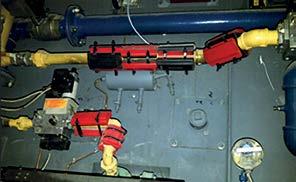
Another assessment there was a power failure and the whole crematory went down so I assisted with restarting both cremators and continued on with the assessment once everything was back up and running. Again the day did not go as planned but in my opinion you learn more about a candidate and what their competency level is when things go awry, which unfortunately they do.
Something unexpected
I visited a council run crematorium approximately 11/12 years ago and although the grounds were well presented, and the cremation processes were adhered to and carried out professionally, the cremators were in need of major overhauls or full replacements. Most crematoriums at this time were in the process of completing business cases to agree funding for new cremators or bolt-on filtration systems to be ready for the legislation changes but this crematorium had no possibility of funds being made available in the foreseeable future and so the equipment had suffered as a result. The crematorium was eventually put up for sale and was sold to a private concern who invested quite heavily and it now has new cremators, abatement and a fully refurbished crematory. This always comes to mind as everyone hates change (especially when it’s council to private through “alternative service delivery”) but this transition proves that it can work, and the surrounding residents get a service that has been invested in and future proofed.
When visiting a crem about 11 years ago I walked through a newly completed extension to the crematory which was put in
26 The ICCM Journal | Spring 2023 | V91 No. 1








powerful core system and a robust collection of optional modules that service all aspects of crematorium and cemetery administration.
Y You choose the modules that you need.

to house the new filtration plant. The extension was in keeping with the original crematory and was seamlessly connected to the original building. The filtration installed within looked shiny and new but didn’t work and the contractors were in the process of removing it, the cost to install was £400k and the cost to remove was £100k.
I understand the project manager didn’t last long after it was turned on.
One of the staff on another assessment had tried to enhance gas flow by attaching magnets to the gas pipes. I don’t know if this worked at all but it’s the only time I’ve seen it attempted.
Another assessment the dust was contained by use of a “homemade dust extraction unit”, a cardboard box and a hoover. Not an ideal solution but it did work. I understand a new unit was delivered about a month after my visit.
Why be an assessor
I have seen many changes in crematorium working procedures and policies and how they have been implemented over the last 16 years especially how crematoria have adapted to new legislation and governing body recommendations. This has enabled me to see how new cremators and abatement installs have proceeded (some good, some bad) and take back with me the additional knowledge I’ve picked up to ensure our own projects have been a success. I can honestly say every crematorium I have visited has carried out the process of cremation to agreed industry standards whether to the “Code of Cremation Practice” or the “Guiding Principles” professionally and with respect.

Even though I have stayed with my current employer for 35 years I have been offered various job opportunities through carrying out the assessments and still get offers to this day. Carrying out the ICCM assessments inadvertently led to me becoming a cremator operations trainer for the council to set up a business model so we had experience on every level of the organisation and had a clear succession plan.

I ended up in the bereavement industry by accident, as I originally trained as an electrician before moving on into this industry as a gardener, grave digger, memorial installer, cremator operator, crematorium supervisor and finally a manager. Being an assessor has enabled me to see other crematoriums, not on a day visit or open day when everything has been prepared, but when the staff are actually carrying out a normal day's work so you get to see what works well or what could possibly be improved on, all whilst assessing a new member of a crematorium team.
My time as an assessor has aided me in my own personal development and the development of those I have trained and assessed. I really don’t think it matters what background you come from to move onwards and upwards in this industry as long as you treat everything you do with dignity and respect and if the opportunity to become an assessor ever arises I would say grasp it with both hands.
So all in all 16 years of good memories to look back on.
Lee Macey
and Cemeteries Operations Manager
The ICCM Journal | Spring 2023 | V91 No. 1 29
When I started... When I finished...
Crematorium
our cemetery
The history of the cemetery site and chapel
Keynsham is a Market Town that runs between Bath and Bristol.
In 1877 the then Vicar and churchwardens of Keynsham, finding the graveyard around the parish church incapable of either receiving any more burials or being enlarged, purchased two and a half acres of ground to make a public cemetery and chapel. This was situated a quarter of a mile beyond what was then the small village of Keynsham on the Bristol side and was part of the fine stretch of meadow land that borders the River Avon, known as the Hams.
Keynsham cemetery was eventually sited in the middle of a very large Roman villa built in the 4th century.
During 1875/6 there was only one topic of conversation in Keynsham, the site of the cemetery.
During this time Keynsham had a population of 2,245 people, somewhat different to the current bustling population of over 18,000. and a burial board was tasked with finding new land suitable for a cemetery but after heated opposition from Keynsham residents they were overturned.
As soon as the works began on the chapel the builders encountered the remains of a Roman house of great size. It was a matter of regret that this Roman house (palace) could not be preserved in situ but this was impossible in the circumstances where the ground was urgently needed for burial purposes.

Archaeologists now recognised that Keynsham villa was not just one of your average villas but could be better described as a palace.
The Bullied Report of 1926 adds that shortly after opening for burials in 1877 a successful objection was raised to burials immediately around the chapel. By 1926 it was necessary to use this area and it was the parish council who encouraged the 1925/6 dig that revealed how much of the villa remained.
The Bullied Report although it records that remains had been destroyed was nonetheless able to reconstruct the layout of the villa and a number of mosaics were recovered.
The first burial took place at the cemetery on 21 April 1878. Our records show that since 1953 approximately 4,500 burials have taken place.
Keynsham town council became the burial authority for Keynsham cemetery in 1996 when the former Wansdyke district council wanted to close the cemetery.

In 1996 a new extension was added with room for approximately 400 lawn and kerb grave spaces and also a memorial garden with memorial plots for caskets was created in 2015.
The cemetery is very well cared for by the council’s grounds maintenance team and has become a peaceful and attractive resting place to serve the residents of Keynsham and surrounding areas.
30 The ICCM Journal | Spring 2023 | V91 No. 1
Keynsham Town Council Cemetery Staff
mental health & bereavement services
Not too dissimilarly to loss and bereavement, mental health for a long time has been (and to a point still is) very much a taboo subject.
If there is any positive to be seen from the pandemic, it is that there has been a paradigm shift in our discourse of such intricate and painful subjects through what was at least a universal loss of normality and at worse for many, traumatic. Westerleigh recognised the toll that the pandemic could place on colleagues and wanted to offer as much support to teams as possible, and so the mental health working group was formed. The group started by gaining a better understanding of what we were currently doing to support colleagues. We spoke to staff, site managers and HR to see what support was currently available.
While it was clear that there were lots of different options for support being offered, our next step was to find out how employees felt about this support. I led a survey into exploring this where we gave all colleagues in the business the opportunity to respond. In total, 25% of the business responded and I would like to share with you some of the results of the survey.
• 56% of survey participants said they would like or would be interested in having mental health first aiders at work.
• 69% of those who participated in the survey would be interested in having more mental health resources at work.
• 68% of respondents said they didn’t think Westerleigh spoke about mental health enough.
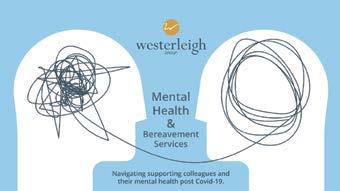
The survey completed by colleagues helped us to decide “what next” and at every point after this, we were guided by these results. We wanted to show colleagues we had listened to their feedback and provide support that was actually supportive and not a tick box exercise or plaster being applied.
After this work had been completed, we had a very clear idea of where we wanted to take the group and the work next. On the 18th of August we submitted an official proposal to the board for how we wanted Westerleigh to support mental health which was approved and is now in the process of being rolled out to the business. This included many different things but I wanted to highlight a few to share with you below.
• Quarterly mental health “bulletin” to highlight awareness campaigns, improve visibility of these campaigns and improve company culture surrounding mental health
• In house basic mental health education to all colleagues with options for additional study and self-improvement.
• Training for line managers in mental health awareness
• The introduction of mental health first aiders regionally across the business
• The introduction of a new mental health meditation and self-improvement platform: “Insight Timer”
• Reinvigorated resource packs for mental health to be available on the intranet and regularly reviewed
Why improve mental health support?
The charity Mind have said that 1 in 4 people will experience mental health problems of some kind each year. Statistically, that shows how many people within the industry may be impacted by mental health at any given time. The impact of this on businesses is huge, with the mental health foundation postulating that approximately 12.7% of all time off in the UK is due to mental ill-health.
We know what we are doing is working. At the end of November 2020 6.29% of the business on average used the Westerleigh employee assistance programme to access mental health services. In the short time we have simply been discussing mental health we are now seeing as of April 2022 14.57% of the overall business accessing the same service.
The mental health foundation have also stated that intervention and assistance by employers does cost money but will show a positive net return mainly through reduced absenteeism.
We have been open in talking about mental health, we have been clear about where colleagues can access support and even in a short time frame, they are accessing it in bigger numbers than we have ever seen before; meaning more people are now seeking support rather than left to struggle.
The ICCM Journal | Spring 2023 | V91 No. 1 31
What can you do in your workplace?
My hope is that sharing this information will inspire you with some ideas for your own workplace. Below are the top three tips that can be easily added to a business at low or no cost. In no particular order;
1. Start talking about mental health more. Casually and practically in team meetings –make mental health a normal part of your conversations not something only HR speak about. Ask colleagues how they are and answer honestly if someone asks how you are. You don’t have to go into “full details” but answering honestly instead of “ok thanks, you?” helps to normalise mental health conversations. Asking how someone else is may just be the start of a road for them to seek help.
2. Educate yourselves in mental health awareness and how to discuss mental health. There are many paid and free courses available. To this point, consider investing in a mindfulness app such as Insight Timer, Headspace or Calm. It could be as simple as making a range of videos from YouTube or the NHS easily available to colleagues.
3. Give flexibility to those needing to access counselling sessions in their working hours.
Mental health advice to you
While creating this article, it felt remiss of me to not actually talk about mental health in relation to you. Mental health impacts every single one of us and in our roles within bereavement services, we are witness to mental ill health every day. With that in mind, I’d like to leave with you with three unsolicited pieces of advice for supporting yourself and others, both in and out of the workplace.
Tip 1 – Do the basics well
• Get enough sleep, food, water, nutrients and deep breaths in a day. Give yourself the best grounding you can to tackle whatever comes next. Consistently doing this has been proven to improve mental health.
• Put yourself first; even in a disaster such as a plane crash, the advice is to put on your own oxygen mask before helping others put on theirs. You cannot help others to the best of your ability if you are not well yourself.
Tip 2 – Let it out & give yourself some grace
• A problem shared is a problem halved; talking about our problems to those we feel safe with is a real way to reduce the impact they have on us.
• On average (according to author Oliver Burkham) we have around 4000 weeks to live. He describes that as “absurdly, terrifyingly, insultingly, short”. Do less but do it better –you don’t have time to do everything in 4000 weeks. You can’t fix everything, learn everything, be the best at everything. So be conscious of your time and do more of what sparks joy. Let it go, you only have 4000 weeks to live; we can put things down simply because they are heavy.
• Practically how can you give yourself some grace and let things go? A simple way is to check in with yourself by asking simple questions. Ask yourself how are you feeling? What can you do to help yourself feel better? Do you need something right now like food or a break? Sometimes stopping to ask these questions can resolve a lot of problems before they get bigger. We can usually improve our stamina bar by doing “one of the basics” mentioned in tip 1.
• Tip 3 – Learn to listen
• Learn how to really listen. If we are listening to someone, truly listen. It’s about hearing how someone feels and acknowledging this, not fixing the problem. Listen with the goal to just hear someone and not to reply.
• When speaking to someone we know is in a bad place (not in crisis), as a starting point if in doubt try asking the following question: “Do you need me to listen, offer advice, distract you or give you space?”
Conclusion
In conclusion, mental health support is vital. We work in an emotionally taxing environment, witnessing tragedy, grief and loss daily. We witness pain and suffering, care for the dead and the living whom they leave behind. We are doing this in a “post covid” world with an environmental and cost of living crisis. In many ways, our teams are under more pressure today than they were when covid first began and it is only natural that we will struggle underneath this immense pressure unless we do something to support mental health before it gets worse.
As we ended our board report; the biggest risk when offering colleagues mental health support options is that we do nothing at all. Thank you so much for taking the time to read this article and I hope that it has given you some ideas to take into your own workplace and a reminder to look after yourself and one another. If you would like further information or have any questions regarding the mental health working group, please do get in touch at sophie.hadley@westerleighgroup.co.uk.
Sophie Hadley (née Scott) Westerleigh Group
32 The ICCM Journal | Spring 2023 | V91 No. 1
ashes to admin

Tales from the caseload of a council funeral officer
When I started working at the council, I hadn't heard of public health funerals. I had heard the rather grim terminology 'pauper's funeral' here and there, but it was so distant, it almost sounded historical, Dickens era stuff; indeed, that's where the term belongs and I always correct its usage, but I immediately digress. I am a disciplined writer of a book, I promise. Anyway, I, like many others, just didn't consider that not everyone had someone to cremate or bury them. An obvious thing when you think about it, and whenever I answer the classic 'and what do you do?' question at social events, I see the same penny dropping for other people as it did for me. Oh yeah, of course, there must be loads of people in that position. People who live alone, outlived loved ones, deviated from society, who are unidentified and unclaimed. They will then lean in close and ask lots of questions before concluding, you should write a book about that. So, I did.
You probably aren't the audience for it, knowing all about the role, being au fait with deaths of all stripes, there are no curiosities to be satisfied or surprises to be had for you here. What a terrible publicity line to take, this is why I leave promo to my publisher. In an effort to bring this back around, there are plenty of the most important thing of all in there – stories. The stories of the people whose deaths brought their lives into mine, and all stories are unique, so maybe you'll give it a punt. But it's primarily to inform the people who don't realise this job exists, and to comfort the people who lie awake at 3am worrying about what happens when they die in their flat with just their cat to call it in or leaving their children with a massive funeral bill to foot. I wanted to show the existence and workings of this fairly hidden work, particularly the human side of it, and to assure people that nobody is lost.
I came to it quite by accident. Firstly, the organisational accident of it being a part of environmental health. A bit of an uncomfortable placement that, and one of the reasons our website only scores nine out of ten in the QSA assessment for usability. We can't ever score ten because the page has to sit in the tree of a department nobody would ever look for it in. There is no funeral team. I'm the funeral team, in between taking calls about dog mess, varying premises licences and doing local environmental searches. It gets lumped in and that's why the service across councils can be variable. I believe it should be a dedicated job. I dedicate myself entirely to it when someone gets called in, but many officers are far too stretched to treat it as anything other than another task in a list of many, and when I hear tales of bad service, I try to put it down to that rather than lack of care.
But back to my accidental recruitment. I joined as an administrator, taking environmental health calls and making worksheets, standard neighbour complaints, a bit of licensing support, very unexciting, which was what I was after, having just left a very stressful job in London. My manager got wind that I had done some writing in my time and that's when this random task that rattled around between various overworked officers eventually landed on my desk of all places. First as a helper to the officer who was revising our guidance pre-audit. I took his draft to see that it made sense to someone picking it up for the first time, I made some amendments, and then I was asked to test it, on the ground, in a deceased person's house. Quite the leap, but luckily I found I had an odd flair for it, with our celebrant commenting that he'd never had so much information for eulogies and the funeral director noting my personal investment in my cases. And so eventually after shadowing the officer, I was gradually made the lead for that area, as they were gradually released back to their many other tasks.
Since taking over I've refined the procedure further, created letter templates to deal with the stumbling blocks I have observed and had to work around - like stubborn banks who insist of letters of probate even though that's for next of kin and we had this argument already last month - I've checked the procedure against new government guidelines, run our web pages past QSA and been used as a good example site in some online training I recently attended. Cases have made the papers and media interest in the role has increased as a result, with The Mirror doing a double page feature on these types of funerals after hearing about one of my high-profile cases. The book is the final step in making sure people know this is available and that there is no shame in needing to ask for the help.
The ICCM Journal | Spring 2023 | V91 No. 1 33
The book covers everything from the nuts and bolts of the job, the stories of the people I've looked after, right through to death itself and all the existential thoughts and feelings that come with it. We were chatting about it in the office the other day and writing an alternative job advert on that basis:
"Previous experience. Must have lived, loved, lost, felt lonely, worried about how many people will turn up to your funeral, realised we will all be forgotten one day but for today you can strive to help someone be acknowledged and remembered one last time”.
It can be consuming, after all, how can you do half measures when it’s something that involves a life. Albeit after death but there is a lot of life administration to close down and a lot of life to seek out and celebrate. Drawing the line between the person and myself has been hard at times, especially when situations mirror my own life, or a case is especially sad. I am learning to balance things though. Involving myself fully for the duration and then, job done, flying off to the next person like a morbid Mary Poppins. The nature of things means that there is sadness but also humour, even death has its funny moments, so I hope it's a balanced and strangely enjoyable read. The book is released on 2 March 2023 but is available for pre-order now from Amazon, Waterstones, WH Smith, and all proverbial good bookstores.
34 The ICCM Journal | Spring 2023 | V91 No. 1
Evie King
To find out how to advertise in the Journal, please visit the ICCM website at www.iccm-uk.com, or email sofia.allana@iccm-uk.com
CEMETERY SAFETY
THE EVOLUTION OF OUR CLASS LEADING SOFTWARE

Managing risk within a cemetery is critical. No matter how simple or complex your operation is, SAMM-Safety will provide you with the essential tools to satisfy H&S legislation and give you complete peace of mind.
Memorial Safety is the first module in the SAMM ‘Cemetery and Crematoria Management’ family. It is supplied with a central diary system, extensive administrative tools and a communication centre that provides a simple and effective desktop hub. The highly intuitive mobile application is designed to operate on any smart phone or tablet.

Memorial Safety is only the first step. We are developing scalable modules to satisfy the wider needs of your cemetery, including asset management, interactive mapping, maintenance of burial records and much more besides.

Early adopters will benefit from a low-cost entry point and the opportunity to influence the design and content of SAMM.
Early adopter prices from just £995 plus VAT



Cath Brew drawntoastory.com
For more information, visit SAMMsafety.co.uk
The ICCM Journal | Spring 2023 | V91 No. 1 35
Powered by
Don’t leave GRAVE safety to chance.
Every year people are killed or seriously injured by excavation collapse. The HSE has increased its expectations of safety measures when working in and around excavations - don’t let yourself be on the wrong side of the law.
You are now required to take ‘all practicable steps’ to prevent ground collapse - and the rules apply equally to graves as they do to excavations on construction sites.






In wet, wintry weather conditions, is your shoring equipment operating correctly and is it sufficient for your needs?




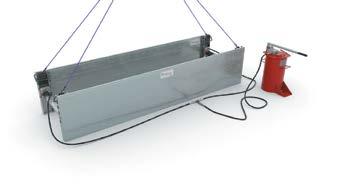
We are the UK’s leading experts on grave shoring solutions and cemetery safety - contact us for advice on appropriate grave shoring solutions today.


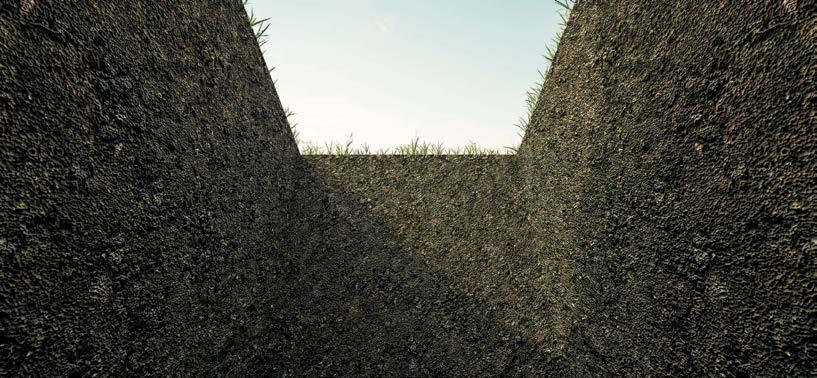
36 The ICCM Journal | Spring 2023 | V91 No. 1 TRUST IN TELESHORE - THE UK’s LEADING EXPERTS IN CEMETERY SAFETY.
YEARS SERVING THE INDUSTRY 28
Hydraulic shoring
TELESCOPIC
shoring & Cover SPEED Braces
Extremely wet conditions this winter may have caused ground movement, with such shifts potentially having an impact on the stability of memorials. Ensure that your cemetery remains safe for the public and your teams by booking an inspection with our Memsafe experts.
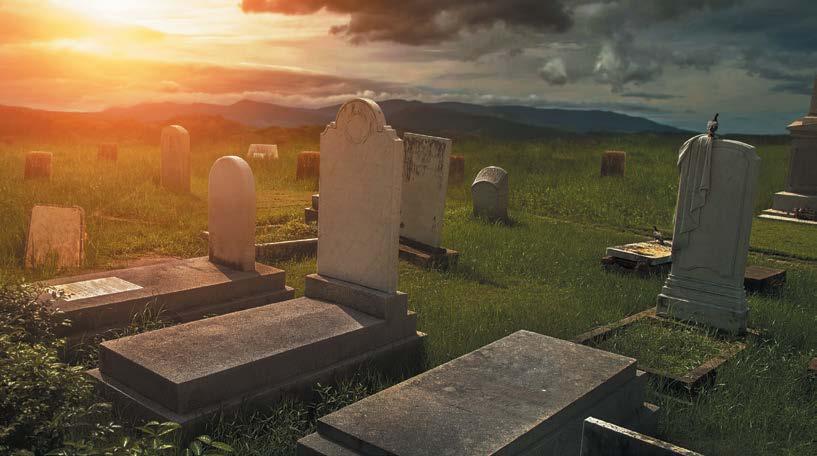
Memsafe is fully BRAMM registered and offers:




•Cemetery Zoning
•Memorial inspections
•Memorial repairs
•Memorial renovation
•Supply of memorial safety equipment

The ICCM Journal | Spring 2023 | V91 No. 1 37 Experts in memorial safety KEEP YOUR CEMETERIES SAFE. ACT NOW.
Nationwide maintenance service for grave shoring equipment AVAILABLE NOW t: 01495 212 232 e: info@teleshore.com www.teleshoregroup.com
muslim burial requirements
When looking to establish a burial ground and cemetery, there are several aspects to take into consideration in order for it to be in accordance with Islamic teachings.
What forms of body disposal are permitted? Do the deceased need to be buried on consecrated ground? Can burial take place elsewhere? Can burials be delayed? Is there a particular way the deceased must be presented prior to and during burial? What must the grave itself look like?
These are just a few questions that may arise and shall be addressed in this document.
Body Disposal: Burial
Of the various forms of body disposal available, the only permitted form for Muslims is burial. In the Islamic faith, it is a communal obligation to bury the dead. The human being is endowed with dignity, with the body being a gift from Allah; it cannot be disfigured, mutilated, harmed or desecrated. Allah said, “We have ennobled the children of Adam” A human body is sacred even after death. The Prophet Muhammad (blessings and peace be upon him) said, “Breaking the bone of a dead person is similar in sin to breaking the bone of a living person”.
Burial of the body is part of maintaining its dignity. In the case of Muslims, specific funerary rites, such as washing, shrouding, the funeral prayer, and burial, serves to dignify and honour our brothers and sisters in faith who have passed on to the next world.
Alternatives to burial are not acceptable. Cremation in particular is forbidden due to it being a direct violation of the sanctity of human beings.
Separate Burial Grounds
Muslims are required to be buried in burial grounds that are consecrated. As a result, meeting faith requirements call for a dedicated burial ground for Muslims. Every effort should be made to secure a portion of land where they can be buried separately.
There are specific rules and regulations in Islam that have to be adhered to during the burial procedures. Having a separate burial area goes towards achieving this.
Haste in Burial
When a Muslim passes away, the burial should take place as soon as possible.
It should also be noted that burial facilities are generally available to contact seven days a week, meaning that undue delay can be avoided where possible.
Regarding the issue of post-mortems, the fundamental principle is that the human body, whether dead or alive, is considered sacred according to Islam. Thus, cutting it, mutilating it and tampering with it in any way is considered unlawful. As noted, a human body is sacred even after death. In the case where a post-mortem is required, consideration should be given to the deceased’s faith. Should the case be that all means have been exhausted to avoid a post-mortem and it is now unavoidable, it is then incumbent that there be a quick turnaround, if at all possible. Even in cases such as these, the stipulation of hastening burials is not to be disregarded or minimised. Where at all possible, a non-invasive post-mortem (CT scan) should be carried out.
Preparation of the Deceased
In Islam, there are specific funerary rites outlined when it comes to the burial of a Muslim. This is to ensure that due respect and honour is maintained for the deceased as they pass on to the next world.
Of these rites, Ghusl (washing of the body) and Kafn (shrouding) must be carried out in a respectable manner prior to the burial. Thereafter, arrangements can be made for the body to be transferred to the burial grounds/cemetery where they are to be buried.
The body should normatively be buried in the shroud only, without a coffin or a box. This is the preferable and prominent
38 The ICCM Journal | Spring 2023 | V91 No. 1
stance; the usage of a coffin or box when burying the deceased is largely considered to be disliked, and should therefore be avoided.
Body Placement in the Grave
Once the deceased’s body has been transferred to the grave, there are guidelines in regards to the placement and positioning of the body therein.
The body should preferably be laid on its right and the face should be facing towards the Qiblah (i.e. the direction of the Ka’bah in Makkah). The Prophet Muhammad (blessings and peace be upon him) has said, “The Bait alHaram (i.e. the Ka’bah in Makkah) is your Qiblah, alive or dead”.
Mounds on Graves
The grave should be raised approximately a handspan in height; this should be done by forming a hump-shape using the soil from the plot itself. There should not be any sort of structure built on top of or around the grave.
As the human body is deemed sacred even after death, the formation of mounds on graves as described above is necessary to maintain the respect and etiquette observed towards the deceased. With such mounds, a grave would be easily distinguishable for any onlooker, leaving no room for doubt as to whether or not a person may be buried there. This is vital as it is considered forbidden to walk or step on graves.
To summarise, Muslim burial requirements are as follows:
Body Disposal: Burial
• Burial permitted only.
• Cremation is forbidden and not permitted.
Separate Burial Grounds
• Consecrated burial grounds required.
• A dedicated, demarcated area should be used.
Haste in Burial
• No delay in burial; hasten as much as possible.
• Availability of burial facilities.
• Post-mortems avoided where possible; consideration of the deceased’s faith; hasten burial.
• CT scan in the case that a post-mortem is required.
Preparation of the Deceased
• Ghusl (washing) and Kafn (shrouding) preparations to be performed prior to burial.
• Burial of the deceased without the box/coffin.
Body Placement in the Grave
• Body positioned on its right side.
• Facing towards the Makkah.
Mounds on Graves
• Grave to be raised above the ground by no more than a hand-span, for distinction purposes.
• No structures to be built on top of or around it.
The ICCM Journal | Spring 2023 | V91 No. 1 39
Mohamed Omar Gardens of Peace
From planning to completion, we’re with you every step of the way.
For over 20 years, CDS has pioneered the development of cemeteries and crematoria throughout the UK and overseas.
You may know us as Cemetery Development Services. We have rebranded and expanded but we have made sure we retained all the core values and expertise that enabled us to build our market leading reputation.
CDS are with you every step of the way from Feasibility Studies, Landscape and Concept Design through to Planning, Construction and Delivery, ensuring a seamless experience from inception to completion.

Our teams of highly qualified specialists - field surveyors, engineers and designers - are committed to creating beautifully landscaped
and thoughtfully constructed developments. Ones that have distinctive spatial qualities but that also offer excellent commercial value, and that are low-maintenance environments with minimal operational costs.
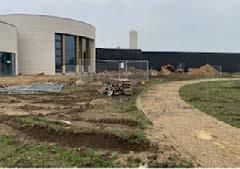
Our Green Agenda also ensures that our developments are environmentally friendly, offer reductions in emissions and pollution whilst helping improve biodiversity.
For more information on how The CDS Group can help, phone us on +44 (0)1525 864387 or visit our website.
Discover what’s beneath. www.thecdsgroup.co.uk Development in Progress – March 2021
official cemetery opening
Thames View Crematorium & Cemetery inauguration
The London Cremation Company opened Thames View Crematorium in January 2017, filling a gap in provision for the bereaved across the Borough of Gravesham. Its modern facilities and extensive views over the Thames estuary proved popular from the very start.
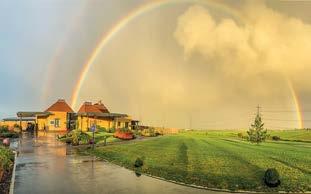
There is now a well-established memorial garden, with around 700 dedicated memorials, providing final resting places for cremated remains and a peaceful place in which to remember and reflect.
Behind the scenes, work was continuing to address the need for burial space within the Borough, with the cemeteries in Gravesend and Northfleet reaching capacity. In May 2022 we opened our Garden of Peace, a natural burial ground meeting the needs of the local Muslim community.
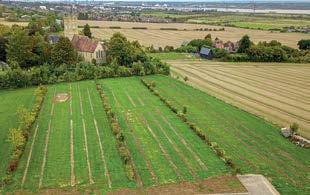
We are delighted to now be able to extend our burial provision for everyone as we launch our formal cemetery. Nestled between our Memorial Garden and the neighbouring St Mary’s Church the cemetery occupies an elevated position, benefiting from the best scenic views offered by our tranquil site.

The ICCM Journal | Spring 2023 | V91 No. 1 41
Lawdin Saldanha
Our cloud-based cemetery and crematorium administration software provides the state-of-the-art bookings and registration functionality, data security and ease of use that you have always wanted. By adding our HeritEDGE digital mapping and the InspectEDGE memorial inspections app, you can truly be in control.
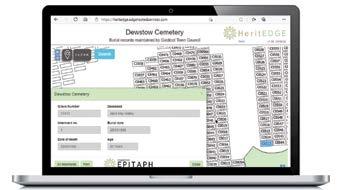
The good news is that you can avoid a costly and time-consuming procurement process by using the Everything ICT framework to make a direct award to Everything ICT for our Epitaph solution. Visit our website for more information. www.edgeITsystems.com/procurement-framework
Epitaph
•Clearly display the current availability of your burial and cremation services
•Easy online access for funeral directors to logon and make bookings 24x7
•Hold and maintain all your statutory register and paperwork records in a secure digital format
•Keep clear and accurate information about each grave, burial, memorial purchase and inspection, and fees charged for products and services
• Paperless administration, complete key documents and staff instructions for daily operational purposes
•Produce an array of management reports directly from the system
• www.epitaph-solutions.com
InspectEDGE
The only inspections app on the market which doesn't require an internet connection!
• Memorial inspections app supplied on ruggedised tablet
• Fully compliant with BS8415:2018 and ICCM guidance
• Simple intuitive interface allows full description of all memorial elements on a grave
• Take up to 4 photographs of each memorial inspection
• Record condition of each memorial
• Specify when to reinspect
•Record memorial location via optional GPS link
•Upload to Epitaph, Access database or Excel spreadsheet
•No access to the internet required, making inspections accessible to EVERYONE
• www.edgeitsystems.com/epitaph/features/InspectEDGE

HeritEDGE
•Digitised mapping of cemeteries and crematoria
•Online access for users via computers and portable devices
•Direct access to grave status and history by clicking on specific plots
•Publish the HeritEDGE link onto your own website for the public to search and print location maps

•Maps are created, maintained, and hosted online by our specialist mapping partner, Pear Technology
•We have over a decade’s experience working with Pear’s geo-referenced maps based on Ordnance Survey
•Live link with burial registers in Epitaph software
• www.edgeITsystems.com/features/mapping
Easy Transition
Please do not hesitate to contact us to arrange an online demonstration and a proposal to migrate you to Epitaph with the security of the Everything ICT procurement framework.
Our team of experienced bereavement service practitioners and IT professionals are ready to provide a smooth and managed transition to Epitaph.
IT Systems Ltd
EDGE IT Systems Limited, Enterprise House, Courtaulds Way, Coventry, CV6 5NX, UK Telephone: +44 (0)24 7666 7337 Email: info@edgeITsystems.com www.epitaph-solutions.com Follow us on social media... CARBON NEUTRAL SOFTWARE
Use Epitaph to take your Cemetery and Crematorium administration to the next level
newark on trent town clerk assists in repatriation of 3 polish presidents in exile
When taking over the role of clerk from SLCC financial adviser Alan Mellor at Newark town council in May last year, I could not have foreseen the incredible opportunity that I would soon get to visit Poland as a guest of the Polish government and attend the state funeral services of 3 Polish Presidents in exile who until November last year had laid to rest in Newark cemetery before being exhumed and repatriated back to Poland.
Such is the incredibly unique nature of the project I felt it prudent to share the experience with colleagues in the sector and highlight particular lessons learnt from the project that may be helpful to other clerks.
The Exhumations
Whilst I am fortunate as clerk to have a colleague who is a highly qualified cemetery manager, that is not the case for all clerks. Exhumations are not easy processes, and I would encourage all councils that manage cemetery and burial processes to become members of the Institute of Cemetery and Crematorium Management (ICCM). They are an excellent source of advice for any cemetery queries and offer an excellent range of training for cemetery staff.
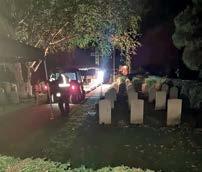
Julie Dunk, Chief Executive of the ICCM was consulted very early on during this project and attended the exhumations of the Presidents herself. She was a great sounding board for the exhumation plans and processes and gave us confidence in the way we approached the exhumation process. In this instance, due to the high-profile nature of the exhumations we used a third-party company who specialise in exhumations to assist with the process. With the Polish government covering all costs of the process, this made perfect sense.
Farewell Mass
On Sunday 6th November a farewell mass in the local church was held followed by a service in the ballroom of Newark Town Hall. Both services were televised live in Poland and were attended by a large number of TV and media organisations from both the UK and Poland.
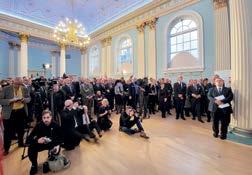

One particular highlight of the project for me was seeing the incredible amount of work that goes into the TV production of a live event of this nature and working closely with the production crew across the church and town hall venues to ensure any venue challenges for TV production could be overcome.
In the lead up to the services, my biggest headache had been around the security threats that some of the potential guests may have presented. Invitation lists included members of the royal family and former prime ministers which inevitably attract a level of security threat. Ultimately whilst the event was attended by royal household member the Earl of St Andrews George Windsor their status is such that security risk levels are fairly low compared to more senior members of the royal household. Despite that we had little choice but to plan for the high security threat guests that might have accepted their invitation.
Safety Plans
The potential security risks were such that involvement of the local SAG (Safety Advisory Group) was sought. Most district authorities will operate some form of SAG group that pulls together various agencies such as police, fire, ambulance and highways. Any clerk involved in delivering any large-scale event should always consult with their own local SAG group for advice at the earliest possible opportunity.
The ICCM Journal | Spring 2023 | V91 No. 1 43
Newark Town Hall Ballroom
Farewell Mass in local Church
On the day of the services, through a combination of road closures, use of security staff, and the deployment of security barriers we created a sterile area between the church and the town hall. This allowed free movement of guests between the venues without interference from members of the public. Our only issue of concern on the day was when an unknown gentleman appeared on the roof of a nearby building. This was quickly reported by stewards and following the safety plans in place the gentleman was identified by CCTV control as a resident in the building who we later learnt had taken refuge on the roof due to a serious water leak in his flat. Thankfully not the sniper that our sinister minds all feared when he was first spotted.
Newark on Trent’s Polish Twinning Links
Mindful of Newarks connections with Poland by virtue of a twinning charter with the Polish town of Sandomierz I very early on asked the Polish consulate to ensure that wherever possible colleagues from Sandomierz would be invited to the events involved. As it was the Mayor of Sandomierz who was invited to join a large delegation who flew in from Poland on the day of the farewell mass, and whilst they were unable to attend services in Newark, they did join us for the funeral services in Warsaw the following week.
Mayoral visit to Poland

Very quickly during the development of the project plans it was made clear that the government of Poland would extend an invitation to 4 delegates from Newark to attend the funeral services of the presidents. Whilst I certainly didn’t feel worthy of attending given that I was such a new face in Newark, and indeed I made clear that sentiment, the council insisted that I attend with the Mayor and be responsible for the safe custody of the Mayoral chain of office.
Newark Town Council invited a representative from the Commonwealth War Graves Commission in recognition of their management of the war graves area of the cemetery in which the 3 presidents had been buried. I was therefore joined on the trip by Sir Bill Rollo (vice president of the Commonwealth War Graves Commission and former Lieutenant General of the British Army).
The final invitation went to The Lord Lieutenant of Nottinghamshire however their diary was such that they could not attend and so we were ultimately joined by a reporter from our local newspaper.
Presidential Funerals
On Saturday 12th November I experienced an incredible day involving a military led service outside the Polish government terminal at Warsaw Chopin Airport to welcome back the presidents as they landed back in Poland.

This was followed by the funeral service at the Temple of Divine Providence in Warsaw which was attended by many senior members of the Polish government.
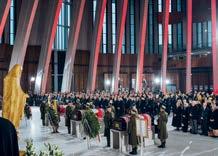
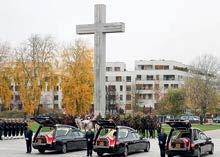
44 The ICCM Journal | Spring 2023 | V91 No. 1
Matthew Gleadell Town Clerk, Newark Town Council
Mayor of Newark on Trent Cllr. Laurence Goff speaking to Polish Prime Minister Mateusz Morawiecki shortly after the funeral service.
Preparations and the Funeral service at the Temple of Divine Providence.
Pear Technology Cemetery Mapping Services
Pear Technology have over 15 years’ experience creating highly accurate, georeferenced and interactive cemetery maps able to link to burial records, photographs and documents.

We use Ordnance Survey’s premium OS MasterMap® Topography Layer map data and are also able to create cemetery maps based on UAV aerial imagery.
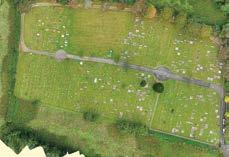


Every plot on a Pear Technology map is an individual entity that can be selected as required. The maps remain crystal clear even at the largest magnification unlike scanned picture maps. Zoom in and out, print sections and click on individual graves to view the relevant burial records.





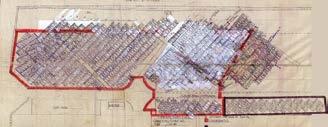
We work closely with popular cemetery administration software suppliers including Edge IT Systems Ltd, ClearSkies Software and Rialtas Business Solutions software. When using your burial administration system click the ‘show on map’ feature to easily identify where a grave is located. Maps can also be linked to an Excel spreadsheet or custom Access Database using Pear’s PT-Maplink software.

»
»
»
» Surveyors CAD plans

» GPS Surveys
If you have no usable maps we are able to help you source information we can use. We can also provide our clients with a register and map scanning service, as well as transcription service through our trusted partners.
I F B D H G Legend Sections Future Graves To register interest, please contact info@peartechnology.co.uk or 023 9249 9689
Why is a cemetery map essential? » It is a legal requirement » Identify and/or sell pre-purchased graves » Enable the public, contractors, cemetery staff and ground staff to locate graves » Identify how much land is available to be used » Trees, drains and benches can all be mapped allowing you to manage the land effectively We can work from various sources including:
Scans or
of
maps
photographs
original paper
Excel
or Word Diagrams
Aerial imagery from UAVs or other specialist suppliers
After
Before
© Crown copyright and database rights [2022] OS [AC0000822731]
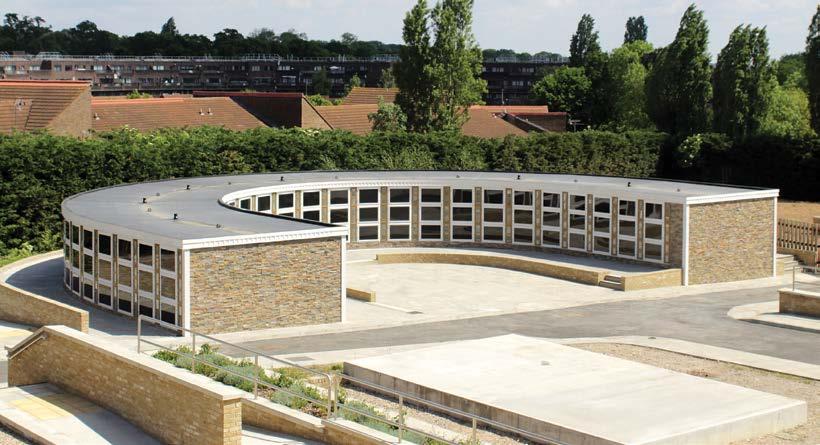


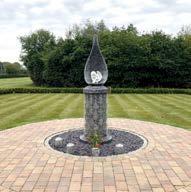
Our NEW Brochure is now available! Greenbridge Designs is dedicated to providing innovative products that add real value to cemeteries and crematoria. With focus on design as well as function, our exciting range of memorials, mausolea and vaults have been developed to fulfil the needs of cemeteries and crematoria in the 21st century. With design studios, state of the art factory facilities, a NAMM trained installation team and customer service support all based in Evesham, you can be assured of an efficient professional service throughout. For more details call 01386 848908 Or visit www.greenbridgedesigns.com
Greenbridge Bespoke Mausolea
how to attract new employees as a crematorium or cemetery using social media?

This is a great question. Life has changed so much in recent years, especially since the pandemic hit. People have changed careers and it has become harder and harder to attract staff for all industries. Social media is a great way to get in front of your future employees and let them get to know who you are, gain an insight and feel for what it is like to work for your crematorium or cemetery.
Stats
To give you an idea of the latest stats regarding social media and it’s usage around February 2022 in the UK: (see https://datareportal.com/reports/ digital-2022-united-kingdom report)
How do you get in front of your potential employees?
There are a couple of key things to consider. Firstly, be on the right channels. These must be fully completed, active and look interesting. So, what are the right channels? No matter what age your future employees are, the most popular channel they use is….. not a social media channel, but a search channel; which is Google. And that means having a Google Business Profile. This is where your Google Reviews are housed (which potential employees would look at) and so much more, it’s a very valuable channel and as important as your website.
Your website is “your shop window” and potential employees will get a vibe about your company culture. Having information and photos, even videos on it with the people behind the business will make a great impact.
Next comes WhatsApp Business, as so many people like to text message and more, it’s a channel that was built with easy communication for small to medium businesses in mind. Here your potential employees can see your business profile as no doubt they are WhatsApp users too. This channel can be connected to your Facebook and Instagram accounts for ease of communication.
After that Facebook, which is expected as it’s the most popular social media channel, think of it like a social media website. You have so many options with this channel compared to others such as different sections such as an About, Services and Reviews sections and these also will be looked at by potential employees. Instagram is a very visual channel, and it has taken off even more with Instagram Reels (videos) which are super engaging and have a wide and far reach. And I have no doubt, a channel your future employees are on.
Not forgetting LinkedIn which is like your business card and lots of your future employees will be on that platform looking to see what job opportunities are available and interesting.
And yes, Twitter is a real communicative channel where the latest news and opportunities are showcased, plus it is a valuable social listening tool for checking out what people say about their experience of many services and it’s a great way to be found by people who don’t live near your crematorium or cemetery. And yes, yet again your potential employees will be on Twitter too.
Posting and Engaging
I just wanted to highlight some of the main channels to consider (yes there are more) and from there your content matters. What you post is super important and looking to see what’s working and what’s not working. Yes, it’s important to have a good mix of content (eg: videos, photos, your team’s stories of their journey into the crematorium or cemetery service etc…). Even showcasing an award, you have won or one of your employees have won is interesting. The Good Funeral Awards 2022 were recently held, and I noticed that “The Gravedigger of The Year” was won by a woman which was great to hear. Sharing different aspects of your business is a great social media strategy to attract and engage future employees, but that’s not all.
Content is King and Engagement is Queen. Social media is a two-way street. Don’t just post and ghost as they say. You must show you are interested in your community by liking and commenting back on what people have said. This will show that you are approachable and encourage people to reach out either by a private message or make a call. And if you are posting about a
The ICCM Journal | Spring 2023 | V91 No. 1 47
job opportunity then you will more likely gain more interest.
Another engagement strategy is to like and comment on other local and relevant businesses (such as funeral directors, celebrants, florists, church etc…) social posts and that will also raise your visibility within their communities and widen your visibility to potential employees.
And before I forget you need to use the right hashtags as people search using them. This is a great way to categorise your post and helps you get in front of your potential employees. If you would like to find out more about using hashtags, you can get your own copy of “The Hashtag Handbook for The Funeral Industry” by going to www.fitsocialmedia.ie and download a free copy there today.
All in All
When it comes to attracting your future employees, you need to be on the right social media channels and more. Having your online channels looking up to date, planning a good mix of content, engaging on your own channels and other relevant ones, plus using the right hashtags can all play a real part in attracting your future employees.
If you have any questions or would like more guidance do get in touch with me at either www.fitsocialmedia.ie or email me on eimer@fitsocialmedia.ie
And do follow me on Facebook, Twitter, Instagram - find me there under FIT Social Media and on Linkedin under Eimer Duffy for more ideas and updates. Oh and talking for updates/tips if you would like them emailed to you then go https://www.subscribepage.com/weeklyupdatesandmore and you will receive yours every Tuesday.
Thanks for reading.
tales of a cemetery registrar
Outside
It’s a cold windy winters day, Wrap up warm they do always say.
I’ve four layers on under my coat, A hat, scarf, gloves, thick socks to note.
Eimer Duffy, FIT Social Media
48 The ICCM Journal | Spring 2023 | V91 No. 1
A flask of hot tea too if I have time to make, But with a busy office the loo is the only break.
I’m not saying office work is a bore, But I do wear a smile as I go out the door.
For when outside it is so peaceful, With the work I do so meaningful.
By Anita Fish
MAINTENANCE UK IFZW Maintenance Ltd. Suite C, Huffwood House Huffwood Industrial Estate Partridge Green RH13 8AU West Sussex Tel.: +44 1403 713310 www.ifzw.co.uk info@ifzw.co.uk 100 % reliability 24/7 allround service crematorium and abatement equipment - complete package from design to completed installation forward thinking flexible approach for the long term
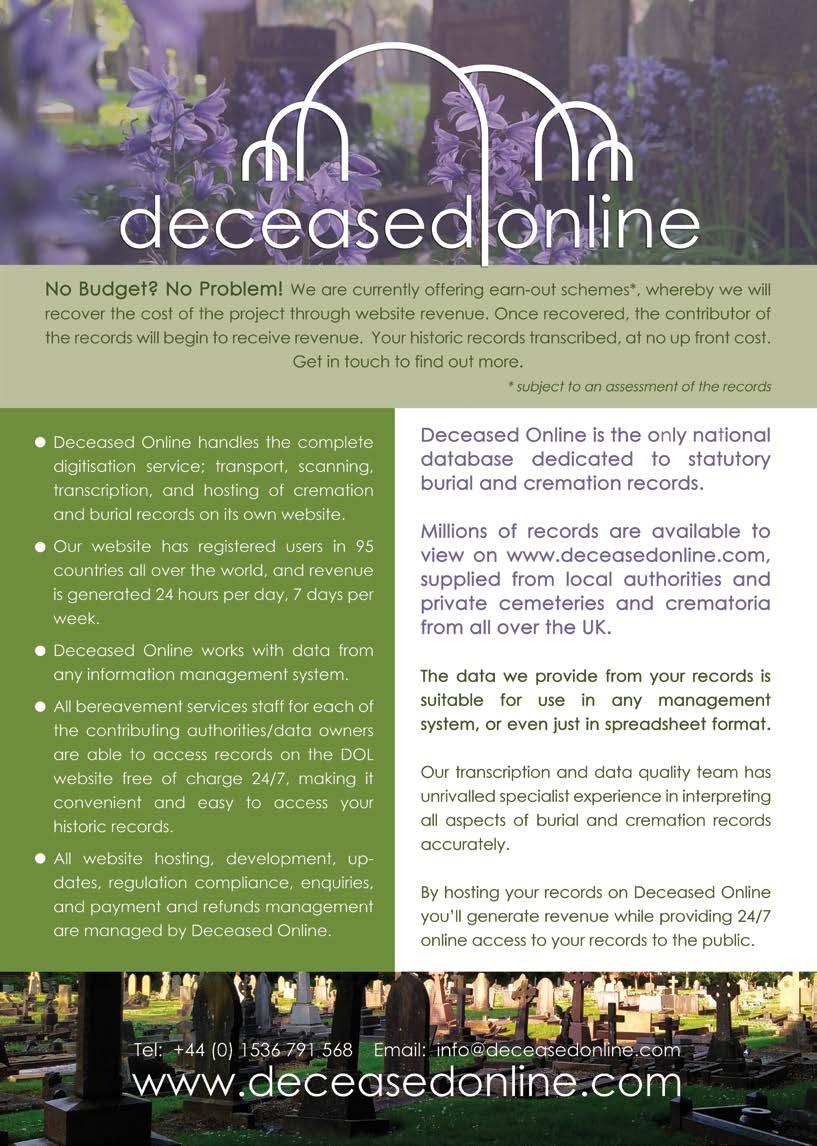
That was the year that was - again?
2022 back to normal after the last 2 years - well let’s think about that. Do we ever go back to exactly where we were after change?
Realistically we don’t, it’s just a fact of life. We move on and things change and adapt. The problem is that after 2020 through to early 2022 things went a bit wrong didn’t they, and what we all wanted was things to be different and so back to “normal.”
Rather then being more pessimistic isn’t it better to think – ok everything has changed we have moved on, whether we wanted to or not; but there are still things that we liked from before that still happen and will happen again.
Yes we can’t get the time back - however, quoting JRR Tolkien for once –
“I wish it need not have happened in my time,” said Frodo. “So do I,” said Gandalf, “and so do all who live to see such times. But that is not for them to decide. All we have to decide is what to do with the time that is given us.”
Maybe we just need to be more positive in the face of controllable events and enjoy them.
In 2022 the Northern branch managed to restart its meetings in July and December, a first having a chilly December meeting in Newcastle after the post-heatwave one in Durham.
Once again being able to physically chat and discuss problems and solutions with colleagues shows the value that networking/meetings can have. It brings help and support to the profession.
We all have different problems and in cases different solutions, one size doesn’t fit all for the industry. We have different customers and different needs. Much like pubs. There isn’t a single pub that can suit all tastes, we’d need a physical bar half a mile wide to have all the drinks and multiple floors for busy, quiet areas – it just wouldn’t work.
What does matter is dealing properly with your customers and their needs within your own limits of space/budget and choice, while being able to communicate with them as well as possible.
September 2022 brought the return of the ICCM Convention for the first time in 3 years – it wasn’t the same as the last event, because the outside world has changed, more renewable materials for memorials from some suppliers, new topics for papers and discussions.
It’s a Learning Convention and every year we all learn some new things that replace other ideas or practices.
Wikipedia defines this image as the - The ouroboros which is an ancient symbol of a snake or serpent eating its own tail, variously signifying infinity and the cycle of birth and death.
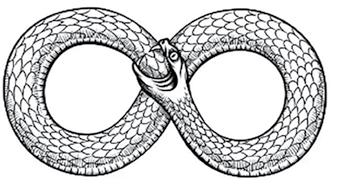
Courtesy of https://depositphotos.com/vector-images /snake-eating-tail.html
Fitting for our industry, we’re constantly learning and evolving. Life goes on and changes, but never goes back on itself – we’ll never get back to 2020 and what we counted as “normal,” but we are now in 2023, this, whatever we’ve got now, is our “ normal. ”
Trevor Robson ICCM Finance and IT Manager

The ICCM Journal | Spring 2023 | V91 No. 1 51
in
north
touch - up
plymouth’s new crematorium project
In a quiet corner of countryside on the outskirts of Britain’s Ocean City, Plymouth's brand-new crematorium is beginning to take shape.
Years in the planning, the Plymouth City Council-backed £29 million project is set in 17 acres of Devon's finest greenery, with gently sloping hills and south facing views over nearby woodlands and Saltram Park.
Designs for the scheme, produced by local architects Stride Treglown and Aecom, have been developed with insights from the public and the funeral industry, after an extensive consultation exercise over the last few years.
The new facility will include three non-denomination ceremony spaces with flexible seating, waiting areas, offices, a new crematory and three new cremators with the latest environmental protection equipment.
Inspired by the picturesque countryside, the buildings will nestle into the slope of the site and will be surrounded by pooled water. Plymouth limestone is being used with windows that provide light and stunning views out over the water, and the local Devonshire scenery and beyond.
Inside, light and open ceremony spaces are in keeping with the desire to provide a modern quality facility. Outside, reflective spaces, designed for memorialisation and scatterings will embrace the local environment and ecology.
In order to deliver the project, a multi-disciplined project board is being headed up by Dr Ruth Harrell, director of public health for Plymouth.
"The last time the council designed a new crematorium was in the early 1960s," explains Ruth. "So while our current facilities have certainly served the city well, it's time for a change. “We know how important the day of the funeral can be in supporting people who have been bereaved. Our need to replace our aging cremators gave us the opportunity to look afresh at what people might need to support them on that day, and into the future, as they move through the grieving process.”
Part of these plans is the inclusion of an on-site café, which will be open to serve refreshments for people attending funerals and also for those visiting the site to pay their respects. It will also be available for families to hire for wakes.
Karen Jennings has been Plymouth city council's head of bereavement services for over 20 years.
"I'm so pleased that we've been able to include the café and wake facility in the designs," said Karen. “As well as managing funerals of different kinds for many years, and watching the way a funeral service has evolved over these years I've also been to a fair few myself. People often come from far and wide, they stay around outside, they want to catch up before and sometimes after, and they've got nowhere to go. By having this facility on site, but slightly away from the main crematorium, we'll be able to make what can be pretty tough days that little bit easier for people."
When the new crematorium is finished, it will replace the existing, aging facilities at Efford and Weston Mill.

Karen added: "While looking to the future and our new facility, we also have to respect our past and in particular, the traditions of families in Plymouth.
"Generations of families will have said their final goodbyes at Efford and Weston Mill, and it's important that we acknowledge that and ensure that for those who want to, the sites remain open for burials and memorials.”
Contractors Kier Group were appointed as main contractors on the project earlier this year and as part of the deal, are ensuring that 85% of SME sub-contractors come from the surrounding postcode and will work with local education establishments to provide a series of placements.
The new crematorium is scheduled to open in 2024.
Jasmine McNicholas Communications and Campaigns Officer
52 The ICCM Journal | Spring 2023 | V91 No. 1






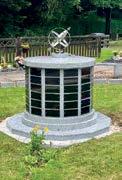


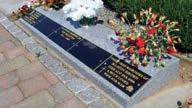
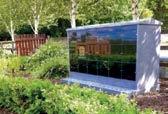





Previous Open Day Have You Got Something Interesting to Share? Are you involved with an innovative project? Are you opening a new site or extending your existing site? Have you introduced any environmental initiatives? Have you introduced a new service or new ways of working? Have you held any virtual events? Are you doing something that others should know about? Why not write an article for the journal? We would be delighted to include any articles from anyone that would like to share their experiences with other members. Need help? We are here to offer you any assistance or guidance with putting your article together. Please contact Sofia Allana on sofia.allana@iccm-uk.com or phone 07502 627521 C o n t a c t F i n d e r s f o r f u r t h e r d e t a i l s q u o t i n g t h e r e f e r e n c e : F R E E N E X T O F K I N T R A C I N G S E R V I C E T : + 4 4 ( 0 ) 2 0 7 4 9 0 4 9 3 5 E : p u b l i c @ f i n d e r s i n t e r n a t i o n a l . c o . u k W : w w w . f i n d e r s i n t e r n a t i o n a l . c o . u k I C C M 2 3 W e c a n o f t e n l o c a t e n e x t o f k i n w i t h i n 2 4 h o u r s S c a n t h e Q R c o d e f o r f u r t h e r i n f o Granart - making memorials for over 30 years Visit us at www.granart.co.uk – Call us on 01298 814 899 – Email us Info@granart.co.uk Granart_ltd • Granite Towers • Memorial Kerbs • Ash Vaults • Columbariums • Photo Plaques • Local Stone • Benches • Plaques • Carvings
ni cemeteries and crematoria education seminar october 22
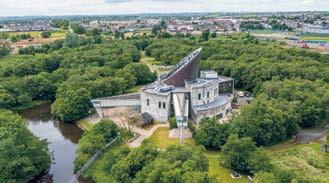
In October of last year, bereavement services providers from across Northern Ireland came together for the inaugural NI Cemeteries and Crematoria Education Seminar.
Hosted by deathcare management software providers PlotBox at their head offices in the Ecos Centre in Ballymena, County Antrim, the event provided an opportunity for local authority cemetery operators to engage with one another, to learn and to share knowledge on key deathcare issues.
Guest speakers included ICCM Technical and Member Services Officer, Mathew Crawley and Teleshore Group Operations Manager, Richard Smith, as well as members of the PlotBox team, who detailed some of the latest innovations that can help users to get the most from the deathcare management solution.
In his welcome, PlotBox CEO Sean McAllister acknowledged how great it was to be able to meet in person following the challenges posed by social distancing over the past two years, and how beneficial it was to be able to connect with those who faced the same challenges.
Echoing those sentiments, PlotBox solutions consultant Niall Adams outlined how the event was designed to provide an opportunity to collaborate and talk about the common pain points faced by bereavement services providers in the course of their daily work.
In setting the scene, Niall explained how PlotBox’s mission of ‘helping to take away some of the pain around dealing with death - for families, and those who serve them’, reflected a partnership paradigm of collaborative working, with PlotBox providing the tools to enable cemetery operators to spend more time with families. He went on to remark how timely the event was, coming shortly after the launch of the UK Commission on Bereavement 2022 Summary.
Key findings highlighted included a significant increase in people who were bereaved in NI in 2020 and 2021, as well as 61% of adult respondents having difficulties with at least one practical or administrative task following bereavement - posing the question: “How do we simplify the process for them?”.
The ICCM’s Mathew Crawley was next to the stage and provided delegates with an overview of his role as technical and member services officer, and a historical overview of the ICCM, its role in working collaboratively with other agencies, organisations and individuals in providing guidance, support, training and consultancy services, and its constitutional basis, as well as its key objectives.
Mathew then described the nature of the ICCM’s training and educational services, and how this is provided in practice by its officers across the UK. He went on to explain how they were able to move training online during Covid-19, as well as highlighting the increased need for training within specific areas, such as the disposal of ashes, reflecting what was happening on the ground.
Mathew also spoke to the importance of collaboration and
representation, indicating the benefits of ICCM membership, and in terms of his role and that of the ICCM, provided assurances that bereavement services operators would be provided a voice.
In closing, he highlighted that while there were some individual differences in terms of legislation between the Local Authorities Cemeteries Order 1977, and the Burial Ground Regulations (NI) 1992, these were nuances, and whether in England or in Northern Ireland, service providers ultimately share the same challenges and the same goals.
Mathew said, “‘It was wonderful to have the opportunity to engage with a wide array of those working within the ‘bereavement services’ setting in Northern Ireland and in part, be able to showcase the support, training and guidance on offer to current and potential members of the ICCM. This collaborative approach was highlighted during the question-and-answer sessions following both the ICCM, Teleshore and PlotBox presentations.”
Following Mathew to the stage was Teleshore Group Operations Manager Richard Smith, who delivered a presentation on the history of the group’s companies, leading to an in-depth look at modern memorial safety management, with key insights for good practice.
Under title, ‘The Good, the Bad, the Future’, Richard examined memorial safety inspection issues, touching on some of the negatives, looking at the positives and what future good practice looks like - noting that the ‘future’ means ‘now’.
In terms of the ‘the bad’, Richard pointed to some of the conflicting ‘best practice’ and advice that was originally released, before mentioning how much of the industry took the knee jerk reaction to simply lay flat any memorial that was unsafe, or later on stake and band every memorial.
Laterally Richard also looked at how some of the issues have also included a lack of staff to carry inspections and a way of communicating that was not proactive - before highlighting the need to have a good communications strategy going forward.
In terms of ‘the good’, he indicated that memorial inspections
54 The ICCM Journal | Spring 2023 | V91 No. 1
are becoming more commonplace, with calls for local authorities to put tighter permit schemes, and most working towards or having a memorial safety policy in place. Richard also highlighted the need for the adoption of a risk-based approach and utilising the data to build an itinerary of memorials across the authority, with a realistic approach underpinned with a five year rolling program.
In terms of good practice for the future, Richard highlighted the importance of zonal risk assessments, as well as training staff to carry out memorial checks up to a certain level, incorporating and recording the 3- or 6-point check before opening graves, hybrid working arrangements with contractors and employed labour, and ensuring that operators are open to the top six methods of ‘make safe’ and not just one.
Finally, Richard pressed the importance of communication, with the need to ensure that we are engaging with members of the public.
Richard said, “It was simply fantastic to be out seeing a group of industry colleagues and getting to really discuss issues that these teams are facing on a day-to-day basis. From shallow grave problems to memorial safety, training and more, it was great to work alongside Mat from the ICCM and the PlotBox team, ensuring that between us we were able to give not only the legal standpoint, but also the operational perspective and occasionally look at products that go some way to making problems a little less stressful to deal with.
Teleshore has always been based on solving customer issues and this was no exception. I was fortunate to catch up with a few customers that I have known for a number of years, but it was also fantastic to meet so many new faces and to get some collective ideology going forward that I am confident will further assist the whole industry.”
Following the break, customer success manager, Dawn Gregg provided an update on PlotBox’s risk assessment module, demonstrating the features that allow users to search facilities and plots and detail condition, in order to create action plans and create inspection schedules, as well as its application in carrying out risk assessments onsite via a mobile tablet device.
Dawn also provided a breakdown of the module’s new reporting functionality, allowing users to apply filters in order to pull data across time periods and generate reports to provide cemetery operators with a complete picture of their risk assessment requirements.
Next, product manager, Aileen Curry gave an overview of PlotBox’s memorial mason portal, a new feature designed to help streamline processes and facilitate ease of communication between masons and the cemetery, allowing issues to be resolved more quickly and ensure compliance around regulations.
Aileen explained that masons can sign up to use the portal, giving them the ability to request a permit and receive progress updates, cemetery users will then receive request notifications and will also be alerted by email notifications, When the Mason
has submitted the permit, users can review and approve, then allowing Masons to request a time to come onsite, and upload photos of their work.
Niall then returned to provide his thoughts on the importance of accurate, ‘true’ digital cemetery maps, noting that it wasn’t just about the legislative requirements, but that it was important to think about the users of cemetery maps – and how they can gain value from them: from the cemetery’s own usage, the families they serve, and wider stakeholders, for example, genealogists and Funeral Directors or Masons.
In all, their benefit was shown to include areas of service delivery, risk mitigation, maximising space, providing accurate forecasts and pre-planning and meeting changing customer needs and expectations.
Rounding out the day was a stimulating panel discussion, providing the opportunity for open discourse on common challenges faced by cemetery operators, which primarily centered around the practicalities and legislative requirements around maintaining appropriate burial separation and minimum depths permissible, with Mat proffering a common sense approach in terms of what is reasonable and ultimately, lawful, and Richard offering practical solutions involving chambering, and reiterating the importance of communicating with the family.
Speaking after the discussion, Mathew said, “From a cemetery management perspective in particular, whilst the differences in burial legislation between England and Wales, and Northern Ireland were evident, I feel it was beneficial for all in attendance to be able to discuss pivotal issues such as permissible grave depths, unauthorised memorabilia and burial tombs to name a few, and to understand not only that which we must do under statutory instruction, but how to tackle these issues in ‘realworld’ settings.”
The event proved to be popular with delegates, with Ards and North Down Borough Council Parks and cemeteries manager, John McConnell saying, “The recent Seminar, hosted by PlotBox, was a great opportunity for those in public sector bereavement services to come together to hear from industry professionals and discuss common issues which are faced across the sector.
The presentations were extremely informative and well received by all delegates. In addition to the seminar, a number of delegates then attended the inaugural meeting of the Northern Ireland cemetery managers forum to discuss the seminal content further and ongoing key cemetery management topics.
This group will be integral to benchmarking our cemeteries services and work in collaboration across the sector. Many thanks to our colleagues at PlotBox for hosting and facilitating the Forum meeting.”
If you would like to know more about the benefits of digitally transforming your cemetery, visit: www.plotbox.io
The ICCM Journal | Spring 2023 | V91 No. 1 55
Graeme Arthur
Don’t leave GRAVE safety to chance.
Teleshore



Can burial vaults help to solve some problems for the UK?
Every year people are killed or seriously injured by excavation collapse. The HSE has increased its expectations safety measures when working in and around excavations - don’t let yourself be on the wrong side of the law.
You are now required to take ‘all practicable steps’ to prevent ground collapse - and the rules apply equally to graves as they do to excavations on construction sites.
There are some delicate problems we face in the burial sector, such as shallow depth burials, that may require new tools in our armory to tackle effectively. Here at Teleshore, we constantly review new products and having been impressed by some modern burial vault designs, I am sure that they will be a valuable addition to our industry here in the UK.


wet, wintry weather conditions, is your shoring equipment operating correctly and is it sufficient for your needs?
We are the UK’s leading experts on grave shoring solutions and cemetery safety - contact us for advice on appropriate grave shoring solutions today.
Modern burial vaults are exceptionally strong, yet lightweight, and can be easily installed by two persons. The chambers are completely air and gas tight as well as watertight, meaning everything is sealed to the maximum, making them ideal for shallow depth burial where circumstances require it. There is no need to extend any dig sizes to accommodate brick or block constructed chambers, no purchase of cement, mixing or brick laying. They are easy to use and store, being lightweight and stackable.
The vaults can be pre-installed within the excavation and coffins lowered into them as normal during a ceremony, having no impact on a traditional cemetery service whatsoever, but providing additional peace of mind to families that their loved ones are protected, and to cemetery managers that ground conditions are unaffected by shallow depth burials.
 Peter Smith, Managing Director of Teleshore Group
Peter Smith, Managing Director of Teleshore Group
welters® organisation worldwide


- Nature, Technology, Reuse & Repurpose
INNOVATION BY DESIGN
Creative and original
welters ® having been fighting the winter weather and persevering to ensure that work continues on our sites without interruption. Despite a particularly cold and snowy week prior to Christmas, and battling through torrential rain and mud, work has progressed well.
Hydraulic shoring

TELESCOPIC shoring & Cover SPEED Braces

The installation of multiple interment burial chambers across varying ground levels comprises part of a new phase of works within a cemetery where many previous phases

56 The ICCM Journal | Spring 2023 | V91 No. 1
company news
® welters DESIGN AND MANAGEMENT CONSULTANTS RESEARCH, DEVELOPMENT AND MANUFACTURING ORGANISATION WORLDWIDE
Over the past three decades, welters® have introduced new and innovative above and below ground interment and memorial facilities to the industry. Today, many of these systems are accepted as standard nationwide and the company continues to produce new and original concepts, leading the way into the next decade.
YEARS SERVING THE INDUSTRY 28
natural burial & resilience
Ken West reports on the challenges of natural burials.
I recently attended a meeting about natural burial at Sheffield University, the first meeting for 10 years. The agenda was to consider how the concept has progressed and where it goes in the future.

Since its inception in 1990, natural burial sites have marketed themselves based on their interpretation of what natural means to them. This has created a competitive market in which mowing the grass over graves might be seen as acceptable at one site or seen as the very worst ecological activity at another. A similar approach to using native plants might be observed. One site might plant only native trees whilst another is content to plant a variety including Japanese cherry trees. Indeed, some sites start off planting native trees only to find that the bereaved demand favourite trees, like the cherry, and so change their approach.
However, consideration of native planting has taken on a new significance regarding resilience and global warming. In part that is because Britain lacks a wide variety of native trees, mostly because we were subjected to numerous glaciations. Even the trees we consider native, such as beech and sycamore, might be seen as introductions. The English oak (Quercus robur), the tree that evolved on our heavy clay soils with regular rainfall, tends to dominate large parts of Britain.
Our limited selection of native trees now has to face the resilience challenge. That is, can they survive in hotter, drier summers and wet winters? Can they survive new pests and diseases as the climate warms? If not, we may find that our woodlands begin a decline that we cannot easily reverse. That is particularly true where one tree, such as the English oak, tends to dominate. In fact, in the British limestone areas, such as the Derbyshire Peak District, where I live, such a scenario is already occurring. The native ash is a tree that dominates our limestone dales and ash die-back, a new disease, is killing them in ever great numbers. This is creating a new landscape and the flora and fauna will also have to change and adapt.
Other native British trees include willow, alder, birch, beech, lime and sycamore. These trees, though, have soil and
The ICCM Journal | Spring 2023 | V91 No. 1 57














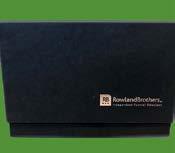











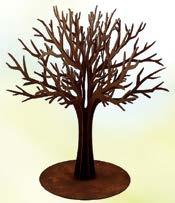
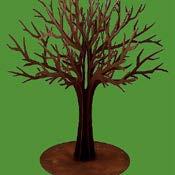

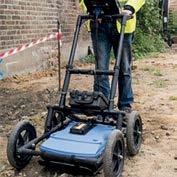
58 The ICCM Journal | Spring 2023 | V91 No. 1
moisture preferences, and the birch has a short life. Consequently, these trees do not mix easily. For instance, beech do not like clay soils. Also, planting just one of these species, as we typically do in plantations, still poses a resilience risk. For instance, because of Dutch Elm Disease we no longer plant the English elm.
I find all this a dilemma, specifically as a horticulturalist. In such an abrupt change, I need to review all my past experience with trees. My choice of English oak for the first natural burial site at Carlisle in 1990 is now considered a mistake. In cemeteries generally, over 45 years, I planted so many non-native, what we call exotic trees, because these areas were defined and maintained as parkland. Nobody questioned my ability and I was given carte blanche to choose tree species. That said, I understood that although the tree may be horticulturally interesting, they were less than perfect for the environment. The Japanese cherry is a classic example, pretty but short-lived blossom and very poor for insects and birds. I could add exotics such as Turkey oak, red oak, cedars, sweet chestnut, walnut, plane, laburnum, maple and many conifers. Now, because we need trees, firstly, to survive higher temperatures in order to lock up carbon, we need to reconsider non-native species.
As a horticulturalist, I lack the skills for this new approach. However, does an ecologist understand the cemetery parkland setting either? And it is not just cemeteries any longer because it also applies to crematoria and even to parks. We need ecology, horticultural and global warming skill sets to define how to move forward.
Although it might sound easy to choose another kind of, say, oak tree, in horticultural terms, all trees vary in form. In other words, they often grow to look very different over time. The English oak has many relatives across the world and includes the Holm oak (Quercus ilex). This tree already exists as an exotic in many cemeteries, parks and coastal areas, where it tolerates salt winds. Coming from the western Mediterranean, one would assume it to tolerate rising temperatures. However, it is an evergreen, dark tree, and apart from its oily acorns, supports little fauna other than grey squirrels and jays. Many horticulturalists would consider it ugly and lacking all the character of our native oak.
Yet, in parts of Spain, it is their native tree. If I created a natural burial site using Holm Oak, it would lock up carbon and yet create an environment entirely different to what we might consider as an oak woodland. For certain, we could walk under the trees but there would be no wildflowers growing beneath, just a mass of tree trunks and dense shade. The leaves of this tree, with very high levels of tannin, take decades to decompose and so cover the ground. Deer and hedgehogs would find this a very hostile environment.
The dilemma is whether we need to offer natural burial that creates a new kind of environment, one that could manage increasing temperatures and wet winters. I could take that to exotic extremes. A few years ago, I lived in Dorset, a chalk county where the oak was uncommon. In fact, due to its already mild climate, palm type species grew everywhere and I had eight in my own small garden. These large plants, of course, also lock up carbon and produce sweet, nectar rich flowers which our bees find very inviting. Consequently, I could create a case for a diverse, garden type, natural burial site as the new resilient option. However, that garden setting would require intensive maintenance and would be prohibitively expensive.
These considerations underlay why natural burial sites come in a variety of types. The oak has created our archetypal British woodland, with bluebells and so many other wildflowers growing beneath. It is an ecology we recognise and love. Added to this, we can leave the trees and bluebells to do their own thing and they need no mowing and very little maintenance. That is why, when I created the world’s first natural burial site, I planted only English oak. I am now having to accept that my vision then, which was before climate change was confirmed, needs to be reconsidered. All those oak trees could be doomed in a matter of a few decades.
These exotics do not come with an ecology developed over millions of years, like the bluebell and the English oak. The exotic alternative trees have left their ecology back in the area where they were the native tree. Nobody has suggested that we transfer that ecology, the actual plants that once lived in partnership with the tree, back in its home range. That would be the logical way forward but it offers huge challenges in potentially threatening our existing ecology.
Can the plant scientists create clones of our native trees so that they are genetically more varied and less susceptible to changing seasons, summer drought and excessive winter rain? Trees that tolerate changing climate and potential disease and yet support the ecology we recognise? Let’s live in hope. If so, I might see the sapling but only our children will see the tree.
The ICCM Journal | Spring 2023 | V91 No. 1 59
Ken West
a look at london's victorian cemeteries

Part 2: Cemetery Buildings
In part-one of this series the development of London’s cemeteries between the 1830s and the end of the nineteenth century was explored. These new burial grounds required a range of buildings including chapels, lodges, ancillary buildings and occasionally catacombs, whilst the whole site needed to be secured with railings. It’s this aspect of London’s Victorian cemeteries that are surveyed in this second article.
The vast majority of Victorian cemeteries in England and Wales possess a pair of chapels joined by a porte cochère. One chapel was used for Church of England service where the ‘Order for the Burial of the Dead’ from the Book of Common Prayer would be read by a clergyman. The second was for services of other denominations including Non-conformists (such as Baptists, Methodists, Congregationalists, etc), and Roman Catholics. The linking porte cochère was intended to shelter the hearse and mourners when entering and leaving the chapel. Invariably designed in the Gothic-style, these chapels have come to be regarded as a hallmark of the Victorian cemetery. Except for one, however, all the cemeteries opened in London during the initial wave (1830-1850) were unattached.
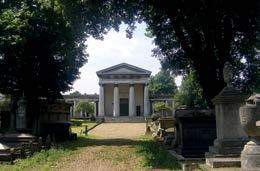
Chapels in the First Wave of Victorian Cemeteries
At Kensal Green, Tower Hamlets, and West Norwood two chapels were provided. In some cases, they were some distance from each other, such as at Kensal Green where the Anglican chapel can be found in the centre of the site, while the Dissenters’ (Nonconformist) chapel forming part of the boundary wall at the east end of the cemetery. Tower Hamlets Cemetery also had two contrasting chapels designed in 1848 by the architectural partnership of Thomas Wyatt and David Brandon. The Illustrated London News (24 March 1849) commented:
…in consecrated ground is in the early decorated period, with a belfry at one angle in which are some nicely ornamented windows; and at the sides are attached cloisters for the reception of mural tablets, so constructed as to afford an effectual screen from the weather. The octagonal Dissenters’ Chapel is in the Byzantine style…Beneath both chapels are dry and extensive catacombs…
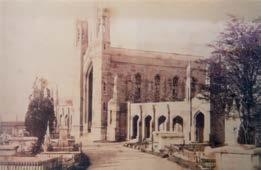
Brompton Cemetery was provided with a single chapel in a classical style flanked either side by office accommodation. This magnificent domed building was restored in 2017. Reflecting its Non-conformist ownership, Abney Park also only possesses one large chapel situated towards the centre of the cemetery. By the 1980s this had fallen into disrepair, but recent work to stabilise the building has taken place.
The chapel in Victoria Park Cemetery was designed by Arthur Ashpital (1807-1869), a Hackney born architect who was responsible for some local churches and private houses. Built in 1845, as the fortunes and condition of the place declined so too did the building and it was demolished probably as early as the 1870s. The only known image of the chapel can be seen in Part 1 of this series.

60 The ICCM Journal | Spring 2023 | V91 No. 1
Kensal Green Cemetery
West Norwood Cemetery
Brompton Cemetery
Abney Park Cemetery
Highgate Cemetery was the first to have chapels that were linked. The porte cochère, however, is narrow so it’s likely that funeral corteges entered via the main gates on Swains Lane and the coffin was carried in from the courtyard.
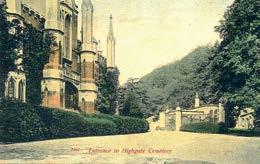
Chapels in the Burial Board Cemeteries
The Burial Board cemeteries that opened following the Burial Act 1852 often engaged the local surveyor to provide the buildings or invited designs by holding a competition. Hampstead Cemetery is an example. In some cases, a well-known architect provided the buildings. Three chapels were provided at Camberwell Old Cemetery by Sir George Gilbert Scott. He was no stranger to the area as in 1844 Scott was responsible for St Giles Church in Camberwell.
Among the first Burial Board cemeteries was the City of London at Ilford (1856), where the City surveyor, William Haywood, provided two substantial and contrasting chapels.

Dating from 1892, a cemetery with two matching chapels can be found at Garrett Lane, Tooting. Opened by the Streatham Borough Burial Board, William Newton-Dunn was the architect. They both possess spacious arcaded porte cochères set at right angles to the main building.
An example of a chapel as a single chapel can be found at Sutton. The flint Gothic-style chapel was designed by EW Crickmay, surveyor to the Burial Board and it dates from 1889. Another cemetery with two separate chapels is at Wimbledon, which were designed by the noted architect, Bannister Fletcher, senior.

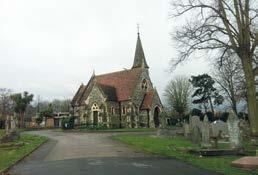
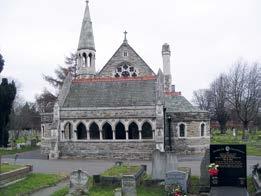
Several Jewish Cemeteries opened in London during the nineteenth century with Willesden Orthodox in Glebe Road being a good example. It dates from 1873 and the prayer hall or ohel and accompanying buildings provided by Nathan Joseph.
The porte cochère was widely adopted by architects engaged by Burial Boards not only in London but elsewhere. All chapels are different in terms of proportions, linking arrangements and external features and there are many interesting examples in the London area including: Kingston (1855), Tottenham (1856), Hillingdon (1867), Romford (1871) and Hampstead (1876).
To match the modest 8½ acre site, the pair of chapels in St Mary’s Cemetery on Bolingbroke Grove in Battersea are perfect miniatures. Dating from 1860, they are around twenty feet in length. At Putney on the Lower Common can be found two chapels (by Barnett and Birch) that are only slightly larger than those at Battersea. In both cases the chapels are joined by a porte cochère, but whereas at Battersea a hearse could stop under the bell cote that joins the two chapels, at Putney this was for pedestrian access only to both chapels.
A simple bell cote rather than a spire can be found in many locations, such as Twickenham (1868) by the local surveyor Charles Jones; there are distinct parallels with his chapels at South Ealing Cemetery.
The ICCM Journal | Spring 2023 | V91 No. 1 61
Highgate Cemetery
City of London Anglican Chapel
Streatham Cemetery
Sutton Cemetery
Willesden Orthodox Jewish Cemetery
Very few architects designed buildings for more than one London cemetery, unlike practices such as Pearson Bellamy and James Hardy who provided many cemeteries in the Midlands and Lincolnshire with chapels and lodges.
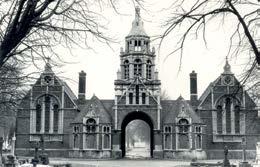

Designed by George Pritchett, Tottenham has the unusual distinction of a room above the porte cochère but without access other than a ladder up to the outward opening window. One of the chapels also possesses some fine stained glass.
Other chapels sport multiple arches. Those at Paddington Old Cemetery in Kilburn (1855) have two spacious arches linking a series of rooms and a central bell tower. At Plumstead Cemetery (1890) there is a single chapel in French ‘Flamboyant’ style where a feature is the semi-circular mortuary chapel forming part of the porte cochère. A local practice, Church, Quick and Whinchop, were the architects.
It’s worth looking in detail at these buildings as there are often differences, some subtle, others less so, that indicate a denominational divide. One strategy was to place the chapels at right angles to each another, so following a ‘T-plan’. Walthamstow (1872) is a good example, and the same arrangement can be found at Queen’s Road Cemetery in Croydon.
Very few chapels bucked the Gothic trend, but the Renaissance designed chapels in Willesden New Cemetery did so. These date from 1891 and are the work of Charles Worley in what Osbert Lancaster calls ‘Pont Street Dutch’. Sadly, they are no longer.

The porte cochère arrangement was also adopted at Golders Green Jewish Cemetery, where the identical chapels are adorned with terracotta dressings (1895).
Chapel Decoration
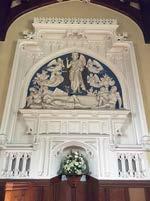
Chapel interiors tend to be plain with little more than just wooden pews, an altar, and a lectern for the priest. Coloured glass enlivened a few, but in the main it was clear. Perhaps the most imaginative addition to the interior of any chapel is at Hendon where a facsimile of Luca della Robbia’s Resurrection in Florence Cathedral can be found. Commissioned by the Abney Park Cemetery Company, it is a delightful addition but surprising bearing in mind the Non-conformist leanings of the company. The colourful mosaics in the sanctuary of the former Richmond Cemetery chapel (now Grove Gardens chapel) is another rare example of internal decoration.
External decoration of the chapels reveals some fine flourishes. At Fulham Palace Road there is a carved tympanum above the chapel door depicting the resurrection scene.
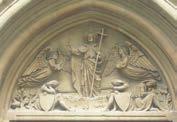
Elsewhere you can find water fountains such as on the external wall of the chapel at Hampstead. At Kensington Hanwell and its Westminster neighbour across the Uxbridge Road along with St Mary’s Roman Catholic Cemeteries there are free standing fountains, originally intended for horses but now used for replenishing watering cans.
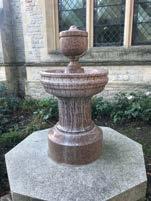
62 The ICCM Journal | Spring 2023 | V91 No. 1
Paddington Old Cemetery
Walthamstow Cemetery
Willesden New Cemetery
The Resurrection scene in the burial chapel at Hendon Cemetery
Pink Granite drinking fountainmat Westminster Cemetery
Entrances and Railings
To reach the chapels, funeral processions and visitors had to enter the cemetery through gates or an entrance arch and a lodge. Kensal Green and Brompton have triumphal arches. There are parallels between the two, but the former, is not dissimilar to the entrance into what was St Bernard’s Hospital at Hanwell.

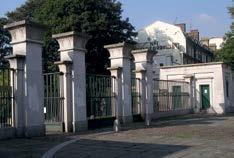
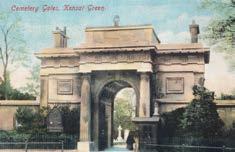
One of the most dramatic entrances to any London cemetery must surely be at Abney Park. This was a pioneer design in the Egyptian style by William Hosking advised by Joseph Bonomi junior, a distinguished Egyptologist. A genuine hieroglyphic inscription in the concave cornice of the office was devised by him. Translated it reads, ‘The gates of the abode of the mortal part of man’.
There are several cemeteries where the entrance arch joins the large lodge. St Marylebone at East Finchley is a good example, along with the City of London Cemetery.
At Plumstead the former cemetery office can be found on one side with the other being the lodge. The whole ensemble dates from 1890 and was recently restored.
The last of the grand entrances was constructed at Hendon where an arch is flanked on either side by offices, formerly a residential accommodation. The lodge was burnt out in the 1980s, but the whole building has just been restored. Other arches worth seeing are at the Kensington, Hanwell and Hillingdon.

Cemeteries needed a lodge for administration and to house the superintendent. Probably the largest is at the City of Westminster’s Hanwell Cemetery, formerly St George’s Cemetery. An appropriate detail is a high relief sculpture of St George above the main door.
Proper enclosure of the cemetery was another feature: there are formidable Gothic-style railings at Highgate and those at West Norwood are particularly splendid. The gates at Ladywell bear the cemetery’s name and the emblem of the former authority whilst municipal coats of arms are proudly displayed on the gates at St Marylebone and Edmonton. At Beckenham Cemetery and Crematorium, Putney Lower Common, Teddington and others, the original railings with attractive designs remain. At Lambeth and Westminster Hanwell, details of the cemetery’s founding and the names of the Burial Board members are recorded on the stone gate pillars.
Symbolism abounds in cemeteries not only on the memorials but on the infrastructure. At Nunhead there are upturned torches on the gate piers representing life extinguished which leaves the visitor in no doubt as to the nature of the site.
Ancillary structures
In addition to the chapels, lodges and entrance can be found ancillary structures. Highgate has a fifteen-arched colonnade at one side of the courtyard beyond the chapel; in the centre are steps giving access to cemetery. The colonnade provides shelter for visitors. Colonnades can also be found at Brompton and around the Anglican chapel at Kensal Green.
At Edmonton the former stables can be found tucked away in a service yard and continues to be used by grounds staff, while at Teddington a small Gothicstyle mortuary chapel still stands but does not fulfil this function.
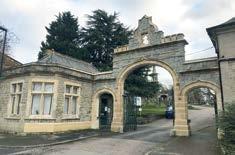
The ICCM Journal | Spring 2023 | V91 No. 1 63
Kensal Green Cemetery
The entrance to Abney Park Cemetery
The entrance into Plumbstead Cemetery
The entrance to Hendon Cemetery and Crematorium
The lodge at Westminster Hanwell Cemetery
Catacombs

Catacombs were built at several London cemeteries. To the ‘Magnificent Seven’ can be added St Mary’s RC Kensal Green, St Patrick’s at Leytonstone along with Westminster Hanwell and the City of London. The usual scheme was a brick vaulted passage, below ground level, equipped either with cells exposing only the end of the coffin or with shelves enclosed by a metal grille or stone panel.
At Westminster Hanwell and Brompton, catacombs were set into a boundary wall. But their popularity soon waned; the catacombs at the City of London cemetery were seldom used and plans to build them at the Great Northern (now New Southgate) in the 1860's were not completed. Space to accommodate coffins still exists at Brompton, Kensal Green, and St Mary’s Roman Catholic Cemeteries. At the City of London Cemetery, a section of unused spaces has been converted into a columbarium.

Part three of this series will be entitled: The Landscapes of London’s Victorian Cemeteries.
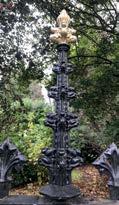


Bibliography
Meller H & Parsons B (2023) London Cemeteries: An Illustrated Guide and Gazetteer Sixth edition Cheltenham: The History Press
Parsons B (2020) ‘The Cemetery Chapel: A Very English Building’ ICCM Journal Vol 88 No 3 pp24-32
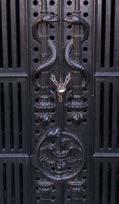
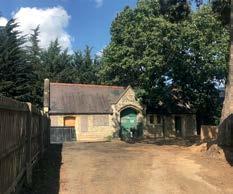
Parsons B (2020) London Cemeteries in Old Photographs. Available from the author’s website.
All images from the author’s collection. www.brianparsons.org.uk
64 The ICCM Journal | Spring 2023 | V91 No. 1
One of the pair of gate piers at Nunhead Cemetery
The Colonnade in Highgate Cemetery
The former stables at Edmonton Cemetery
Detail from the iron railings at Putney Lower Common Cemetery and Islington St. Pancras Cemetery
The iron doorway into catacombs beneath the colonnade Cemetery.
A second catacomb can be found against the western boundary wall at Brompton Cemetery
Brian Parsons
prestigious award for preston cemetery
A cemetery described as ‘really beautiful’ by inspectors has become the latest Green Flag award winner in North Tyneside.
Preston Cemetery, in North Shields, has achieved Green Flag status for 2022/23, having succeeded in its first ever bid for the award.
The Green Flag Award scheme, managed by environmental charity Keep Britain Tidy under licence from the Department for Levelling Up, Housing and Communities, recognises and rewards well-managed parks and green spaces, setting the benchmark standard for the management of green spaces across the United Kingdom and around the world.
Judges were impressed by how clean and well-maintained the cemetery was, citing its biodiversity, overall management, restoration work, and community work as key strengths.
Councillor Sandra Graham, Cabinet Member for the Environment, welcomed the news. She said:
“Preston Cemetery holds a special place in the hearts of local people. It is steeped in local history, a haven for wildlife, and a peaceful sanctuary affording visitors some space and time to reflect.
Our bereavement services team carry out their roles with the utmost dedication and I’d like to congratulate them and all of our award-winning venues on another year of success.”
Preston cemetery opened in 1856 and is the largest in North Tyneside. It is a designated wildlife site and is dominated by large areas of woodland. Within the grounds is Tynemouth crematorium, a recently renovated burial chapel, a Jewish prayer house, two stone cottages which are used as office and welfare space for the bereavement services team and two war memorials.
Funding in 2020/2021 allowed for significant building improvements, while funding in 2022 will enable improvements to the book of remembrance room and garden of remembrance.
There have been over 110,000 burials (including cremated remains) since the cemetery opened. Notable burials include:
• Victor Noble Rainbird, a local painter whose work often depicted the sights of North Shields and other Tyne harbours.
• Thomas William Brown GM, one of the youngest people to receive the George Medal. In October 1942, as a NAAFI canteen assistant, he was involved in the action between Petard and U-559, being one of three men to board the sinking submarine in an effort to retrieve vital documents, and was the only one of the three to survive. These documents would later lead the Bletchley Park codebreakers to crack the German Enigma code. After this heroic deed, it was revealed that he was underage to be at sea. He returned home to North Shields. In 1945 he died from injuries sustained while rescuing his sister Maureen from a house fire at their home in North Shields whilst on leave from HMS Belfast. His family were presented with his medal by King George VI in 1945, and later presented it to the NAAFI in 1985.
The inspection report states:
“Many interesting graves form part of a heritage walk. Buildings have been sensitively restored and contribute greatly to the beauty of the site, particularly the burial chapel”.
“Management and maintenance of Preston cemetery by the operations manager and her enthusiastic and dedicated team has resulted in a really beautiful site that combines sensitively managed bereavement services with leisure provision for the wider community.”
“Preston Cemetery is a worthy Green Flag winner…well done to all involved.”
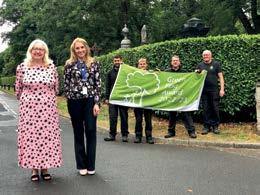
The ICCM Journal | Spring 2023 | V91 No. 1 65
DIGITAL RESTORATION
Have your scans repaired digitally and restore your documents to their former glory before reprinting brand new copies.
DIGITISING
Have your scans transcribed into any data format and use the information in a database, host it online, or simply keep your information safe.
Our scanning, reproduction and archival solutions have already benefitted many different kinds of organisations, including local authorities, professional associations and institutes, local studies libraries and and private collections.
LARGE FORMAT SCANNING
High quality, full colour scanning available for maps, paintings, drawings, fabrics, and other documents of any size.
PHYSICAL PRESERVATION

Specialist neutral, acid-free ways to repair damaged documents, plans, drawings, and more, and prevent further deterioration and damage.
SOLUTIONS
Put your scans online, have them printed, archive your physical records, or use them in a multimedia application.
Manuscripti are one of the country's leading experts in book, document, and map scanning.




The ICCM Journal | Spring 2023 | V91 No. 1 67 We put you and your families’ needs first with reliable audio visual systems. Email jo.muscroft@obitus.com to book a demo or call on 07983 134 063 Positive bereavement experiences Music | Webcasting | Visual Tributes | Audio-visual equipment Thanks to everyone in the Obitus team for your support. The training was really helpful and delivered in a way that was accessible to us all in our various roles. Things went very smoothly and we really appreciated how available you all were to help. Feedback from our chapel attendants has been very positive, they’re enjoying working with all the new functions that are available! Alison Beck , Bereavement Services
Hither Green Crematorium
manager,
how to talk with children about death
Talking openly and honestly about death helps children who have already experienced the death of someone close to them. It also prepares all children for the world around them.
At Poppy’s, we know that these important conversations can also be difficult ones — we often struggle to know where to start. So, last November, we brought together a panel of people with personal and professional experience of supporting children through death and loss to share their ideas and answer your questions.
The panel consisted of Danielle Patton, Widowed Young Support Coordinator for Care for the Family; Pia Clay from the charity Child Bereavement UK; and author, celebrant and end of life practitioner Laura D Pusey. It was chaired by our founder, Poppy Mardall.
In summary, here are five of the guiding principles which our panellists shared.
1. Start early.
You can begin conversations about death in gentle ways before a child has direct experience of the death of someone they love. TV news, leaves falling from the trees, a dead animal by the side of the road are all prompts for discussion.
As Laura says, “This takes the sting out of it, so that they can see death as a natural transition, because that's what it is. Explain that this is something that happens to everybody.
We enjoy our lives to the fullest, we make use of every single day, and then the time will come when we won't be here any more, but the love can continue.”
2. Explore with and include your children.
Some of our hesitation about talking about death with children comes from the fact that none of us really know the answers. Explore with your children. If you don’t know the answer, it’s okay to say that. Ask them how they feel.
It’s not about one conversation where you give them the ‘right answer’. It may be a series of conversations over time, as their understanding grows. Each conversation gives you something to build on.
Pia explains, “Children learn through repetition. You might explain once, then they will go away and process what you’ve said. When they ask more questions later that means they are ready to receive more information. Children need time and space to think about what they feel.”
You don’t have to explain every detail, in particular in relation to a suicide or violent death, but never tell them something which isn’t true.
3. Don’t be afraid to show your own feelings.
It’s important to be sad if that’s how you feel, and to let your children see how you are feeling too. They will know when things are not right, even if you try to pretend otherwise.
Danielle’s husband died when their three children were very young. “I think the most important thing is to be real,” she says, drawing on her own experience. “Show your emotions in front of your child. They are going to watch how you react. Be real and walk with them — you're in this together. It was important for us to keep talking and to keep those lines of communication open, being sensitive to what they may need.”
4. It's okay to reach out for support
In some situations, when you are also grieving, these conversations might feel too difficult. It might help to bring in another adult whom you and your child trust, to help answer questions and to support you both. Professional support, counselling or peer support can also be really helpful.
“It's really important that you have a conversation with the school and with the teachers, so that they are aware. It avoids discomfort on both sides,” suggests Danielle.
68 The ICCM Journal | Spring 2023 | V91 No. 1
Schools can support a grieving child and their classmates. Many schools will have a bereavement policy. If they know the context, they will be able to see if your child’s behaviour changes, understand the reasons why and make any necessary adjustments.
5. Use clear language
Young children struggle to understand metaphors and euphemisms, the kind of language often used when talking about death. This can lead to confusion and sometimes distress.
“If I say somebody's ‘gone to sleep’,” explains Pia. “I think you can imagine how much trouble you may have afterwards, especially for the younger ones. Using direct words helps them to understand what has happened and to know what death is –that the heart has stopped beating and that person won’t be coming back.”
Once children understand the reality of what has happened, using their imagination, art, play and creativity can help them process it and explore their emotions.
Further resources
A longer version of this article was first published on Poppy’s website. You can find the full article, links to resources and support organisations for talking with children about death, and a link to the recording of the panel event, here: www.poppysfunerals.co.uk/talking-death/how-to-talk-with-children-about-death
huntingdon lights up the night
Huntingdon Crematorium was lit up with glittering candles on November 29th as crematorium staff joined up with members of Cruse Bereavement Support to host a Light Up the Night evening.
Many visitors attended the event which was held at the crematorium’s independent wake facility known as Sapley Lodge.
Candles were lit in memory or celebration of a loved one and visitors were asked to add messages to chalkboard memory tags, which were hung on the crematorium’s memorial tree.

Cruse Bereavement Support and Huntingdon crematorium staff were also available to talk with visitors and offer help and support for those who may have been struggling with grief.
The event was organised by staff at the crematorium and supported by central England Co-Op branches, Huntingdon and St Ives as well as Woodland Wishes. All donations provided either by the funeral directors and the visitors went to Cruse Bereavement to support the work that they carry out in the area.
Light Up the Night is just one of their fundraising evenings which has been created to give friends and family an opportunity for shared remembrance of loved ones who have died.
Sam Smith, Huntingdon Crematorium & Cemeteries Manager said “Light up the Night is such a special night when family and friends can come together and remember their loved ones. Although emotional, it was lovely to see the candles and the many tags being placed onto the Memory tree.
We hope it becomes an annual event and want to thank Woodland Wishes and Central England Co-Op for their support with the event, and finally Dawne Hart, Community fundraising and engagement manager – East Midlands and Eastern England, and the local volunteers who came to support and assist families through the evening.”
The ICCM Journal | Spring 2023 | V91 No. 1 69
Poppy's Funerals
Samantha Smith































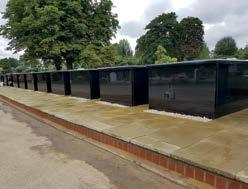



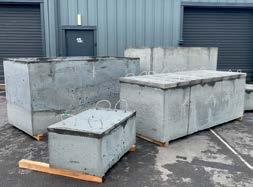




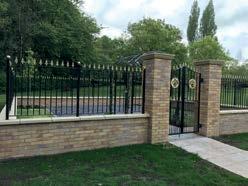






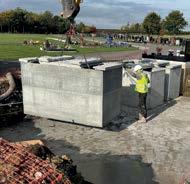











70 The ICCM Journal | Spring 2023 | V91 No. 1 Knowledge, Expertise & Understanding Full Installation & Product Design Service gemprecast@live.com www.gemprecast.co.uk Granite Chamber s Chambers Spec oject s Installation Gabion Walls Drainage Design, Manufacture, Supply & Installation under one roof NEW Manufacturing facilities
iccm board of directors
President
Heather White, MICCM (Dip), Southampton City Council
Tel: 023 8076 6405 Email: heather.white@southampton.gov.uk
Deputy President Marian Millington, AICCM Email: marianw69@gmail.com
Chair Martin Birch, FICCM (Dip), The City of Cardiff Council Tel: 029 2054 4820 Email: Mbirch@cardiff.gov.uk
Vice Chair
Kevin Pilkington, FICCM (Dip), London Borough of Croydon Email: kevin.pilkington@croydon.gov.uk
Alan José, FICCM, Westerleigh Group
Tel: 07881 106 948 Email: ajose@westerleighgroup.co.uk
Tim Morris, FICCM (Dip) Email: iccmtim@gmail.com
Mohamed Omer, Gardens of Peace Muslim Cemetery
Tel: 020 8502 6000 Email: mohamed.omer@gardens-of-peace.org.uk
Linda Barker, FICCM (Dip) Email: barkerlinda1@aol.com
iccm officers
Chief Executive
Technical & Member Services Officer
Technical Services and Journal Officer
Julie Dunk, BA (Hons), FICCM (Dip)
Mob: 07976 939 585 Email: julie.dunk@iccm-uk.com
Mathew Crawley, PGDip FCMI FICCM(DipHons)
Mob: 07581 006 035 Email: mathew.crawley@iccm-uk.com
Sofia Allana, FICCM (Dip) Tel: 07502 627521 Email: sofia.allana@iccm-uk.com
COTS Manager Martin Clark, FICCM
Finance & IT Manager
Administration Officer
Mob: 07940 032 035 Email: martin.clark@iccm-uk.com
Trevor Robson, Bsc (Hons) BSIT, AICCM, MAAT
1 Colbeck Avenue, Swalwell, Newcastle upon Tyne, NE16 3EB
Tel: 0191 452 5958 Email: trevor.robson@iccm-uk.com
Julie Darroux, AICCM, ICCM National Office
City of London Cemetery, Aldersbrook Road, Manor Park, London, E12 5DQ
Tel: 020 8989 4661 Email: julie.darroux@iccm-uk.com
The ICCM Journal | Spring 2023 | V91 No. 1 71
the journal
The Journal is the official quarterly publication of the Institute of Cemetery & Crematorium Management (ICCM). It is the aim of the Journal to encourage the fullest freedom of opinion and expression within the Institute. Unless the fact is expressly stated, therefore, views put forward in the Journal should not necessarily be regarded as expressing the considered policy of the Institute.
The Editor and the ICCM do not guarantee the accuracy of statements made by contributors or advertisers or accept responsibility for any statement which they may express in this publication or inserts therein. No advertisements referring to the provision of training or training centres or any other services will be accepted where it is considered that a conflict with the functions of the Institute exists. Articles are considered for publication on the basis that they are the author’s original work.
No part of this publication may be reproduced, stored in a retrieval system, or transmitted in any form or by any means, electronic, mechanical, photocopying or otherwise without the prior written permission of the ICCM.
Institute of Cemetery & Crematorium Management (Inc.)
Registered Office: City of London Cemetery
Aldersbrook Road
London E12 5DQ
A Company Limited by Guarantee
Founded 1913
Incorporated 1958
England & Wales Register Number 610299
72 The ICCM Journal | Spring 2023 | V91 No. 1
BACAS IBC CDS 40 Deceased Online 50 Edge IT Systems Limited 42 Facultatieve Technologies 17 Finders International 53 Fordingbridge 7 Fraser & Fraser 15 Greenacre Innovations-Gem Precast Ltd 70 Gower Consultants Ltd 28 Granart 53 Greenbridge Designs 35 & 46 IFZW Maintenance Ltd 49 Manuscripti 66 Obitus 67 OpusXenta 11 Pear Technology 45 PlotBox 6 Fibrous Funeral Supplies 58 Teleshore UK Ltd IFC, 36 & 37 TGMS Ltd 18 The Columbaria Company 27 Welters Organisation Worldwide 3
advertiser index
72























 Julie Dunk ICCM Chief Executive
Julie Dunk ICCM Chief Executive












 Marcus Vickers Operations Manager Bereavement Services, Teesside Crematorium
Marcus Vickers Operations Manager Bereavement Services, Teesside Crematorium






























































































































































































